Results 7,791 to 7,800 of 10817
LinkBacks (?)
-
12-26-2016, 11:32 AM
-
09-02-2016, 05:39 PM
-
whole garden made with pallets!! Love it!! | Pallets | Pinterest | Pallets, Pallets Garden and Wooden Pallets
Refback This thread03-06-2016, 11:30 AM -
10-20-2015, 05:29 PM
-
06-12-2015, 08:00 PM
-
02-26-2015, 01:58 PM
-
01-05-2015, 04:13 PM
-
12-19-2014, 10:19 AM
-
EMERGENCY: HUGE FEMA PANDEMIC EXERCISE IN USA IN NOVEMBER, INTERNET SHUT DOWN PART OF EXERCISE | Prepare4Survival
Refback This thread12-03-2014, 10:39 PM -
Off Grid World ? Ugly Duckling Shipping Container Home Built by Artist Is a Beautiful Swan on the Inside
Refback This thread11-25-2014, 03:10 PM -
11-17-2014, 10:59 PM
-
11-13-2014, 11:18 AM
-
11-09-2014, 02:54 PM
-
10-28-2014, 11:38 PM
-
10-26-2014, 05:54 AM
-
10-16-2014, 11:28 AM
-
10-03-2014, 01:25 PM
-
10-02-2014, 09:16 PM
-
09-26-2014, 07:00 PM
-
09-26-2014, 01:56 PM
-
09-19-2014, 04:46 PM
-
09-13-2014, 05:49 AM
-
09-05-2014, 01:52 PM
-
09-01-2014, 09:39 AM
-
08-30-2014, 06:29 PM
-
08-10-2014, 06:29 AM
-
08-04-2014, 05:07 PM
-
07-23-2014, 11:14 AM
-
New Evidence on Expiration Dates | Medical Preparedness | Doom and Bloom (TM) | Doom and Bloom (TM)
Refback This thread07-22-2014, 10:10 AM -
07-18-2014, 08:37 PM
-
07-15-2014, 04:57 PM
-
07-11-2014, 01:40 AM
-
04-22-2014, 11:14 AM
-
04-18-2014, 12:57 PM
-
04-18-2014, 10:10 AM
-
04-14-2014, 12:18 AM
-
04-12-2014, 02:28 AM
-
03-02-2014, 11:43 PM
-
12-24-2013, 11:59 PM
-
12-07-2013, 11:04 PM
-
kitchen | Cob
Refback This thread11-25-2013, 03:24 PM -
10-22-2013, 10:25 PM
-
Apple Pie Braid | Sweets
Refback This thread09-26-2013, 07:58 AM -
09-02-2013, 04:44 PM
-
5 Reasons Why You May have to Bug Out Even Though You Don’t Want to | The Apartment Prepper's Blog
Refback This thread08-23-2013, 03:20 PM -
06-27-2013, 06:30 AM
-
06-23-2013, 08:11 PM
-
06-17-2013, 11:21 PM
-
05-24-2013, 05:06 PM
-
To Eat / BASIC LIST / SUGGESTED ITEMS FOR LONG TERM SURVIVAL - Page 275 - ALIPAC
Refback This thread05-01-2013, 03:49 AM
Thread Information
Users Browsing this Thread
There are currently 1 users browsing this thread. (0 members and 1 guests)
-
07-08-2023, 10:38 PM #7791
15 Grocery Essentials That Will Become Priceless In The Months Ahead! - Epic Economist
Saturday, July 8, 2023 15:43
(5025) 15 Grocery Essentials That Will Become Priceless In The Months Ahead - YouTubeIf you're gonna fight, fight like you're the third monkey on the ramp to Noah's Ark... and brother its starting to rain. Join our efforts to Secure America's Borders and End Illegal Immigration by Joining ALIPAC's E-Mail Alerts network (CLICK HERE)
-
07-08-2023, 10:53 PM #7792
Survival tips: Alternate power sources for your homestead
07/07/2023 // Zoey Sky // 1K Views
Tags: alternative energy, Collapse, electricity, emergencies, energy sources, geothermal energy, green energy, green living, homesteading, hydropower, off grid, power, power grid, preparedness, prepper, prepping, prepping tips, SHTF, solar power, survival, survival gear, survivalist, wind power

If your prepping budget allows it, it's ideal to incorporate alternative energy solutions into your emergency preparedness plan. This ensures that if the power grid goes down after disaster strikes, you'll still have access to alternate energy sources in your homestead.
If you prefer renewable energy sources, consider investing in hydropower, solar or wind power systems. (h/t to TheOrganicPrepper.com)
Knowing about green, alternate energy sources can help you harness nature’s power effectively as you finalize your emergency preparedness plans.
Hydroelectric power
Hydroelectric power is a renewable energy source that harnesses the natural flow of moving water to generate electricity. A dam or reservoir is used to trap water and create a height difference between the water levels on both sides of the dam to produce hydropower. The water then flows through a small tunnel with turbines that generate electricity from an attached generator.
Hydropower is a cost-effective source of electricity that costs less than other power sources. It is a popular alternative energy source due to its nature as a renewable and reliable energy production method.
Additionally, hydropower is considered inexpensive in the long term and is associated with job creation and economic benefits.
Whatever the method, hydropower is easier to obtain and more widely used than most people realize. All states, except Delaware and Mississippi, use hydropower for electricity. In 2020, about 66 percent of electricity generated in Washington state came from hydropower.

However, environmental concerns are also linked to constructing hydroelectric plants, including the potential disruption of natural river flow and impacts on wildlife.
The reliance on river water for energy production can make hydroelectricity susceptible to droughts, which can limit its capacity to provide power for your homestead.
Despite these disadvantages, hydroelectricity is still a viable alternative energy option for homesteaders who want to prepare before SHTF.
Solar energy
Solar power is a renewable energy source that harnesses sunlight and converts it into electricity.
The technology behind solar power has advanced since its inception. Like hydropower, it is also one of the most popular and commonly used forms of renewable energy.
Solar energy can also help reduce dependence on fossil fuels, a finite resource that is becoming increasingly scarce.
Despite its popularity, the initial cost of installing a solar system can be costly. The storage of solar energy can also be expensive.
Solar energy is also weather-dependent. This means that if there are periods of low solar activity in your area, you will still need to use other power sources on your homestead. (Related: SHTF essentials: 7 Alternate power sources for emergencies.)
Wind energy
Wind power is a renewable form of energy that is harnessed via the use of wind turbines. The turbines convert the kinetic energy of moving air into electrical power.
Wind power can potentially generate electricity at a lower cost than traditional energy sources. It can also provide a reliable and consistent source of power in several locations.
But wind turbines can be expensive to install. They are also noisy and visually unappealing and can pose a threat to wildlife, like birds and bats.
Wind turbines may also require additional infrastructure to connect rural areas to urban centers.
Despite these challenges, wind power offers many benefits that make them an ideal choice for preppers.
Other alternative power sources
Here are two more alternative energy sources that you can consider for your homestead: biomass and geothermal energy.
Biomass energy is produced from non-fossilized plant materials such as wood, wood waste and biofuels. Biomass energy can be burned to release chemical energy and produce electricity.
Geothermal energy, meanwhile, derives heat from the planet's hot interior or near the surface. Wells drilled into the earth allow a controlled release of steam or water to the surface to generate electricity. In turn, the planet’s constant temperature is utilized in geothermal heat pumps for heating and cooling buildings.
Biomass is a renewable energy source and it uses organic materials like wood and agricultural waste as fuel. This efficiency makes biomass energy a cost-effective energy solution.
Geothermal energy uses the earth's natural heat as a power source. This makes it a reliable and constant energy source. Geothermal energy requires a specific geography to be viable. Drilling geothermal wells can also be expensive.
Considering energy sources is crucial for preppers and homesteaders because of the unpredictability of natural disasters and other survival scenarios.
When the power grid fails, you will lose access to many of your essential needs like communication, food and heating. But alternative energy sources provide a sustainable solution, and these sources can ensure that you have access to enough energy to be independent even after SHTF.
Before disaster strikes, look into alternative energy sources, along with their pros and cons, to ensure that you have access to a backup power source if the grid goes down.
For more information about your homestead needs, visit OffGrid.news.
Watch the video below to know more about USB solar panels.
This video is from the Cahlen channel on Brighteon.com.
More related stories:
Survival essentials: 5 Solar-powered items you need for your homestead.
Tips for setting up an off-grid power system when SHTF.
Scientists synthesize eco-friendly lubricant oils from sustainable, organic waste.
Sources include:
TheOrganicPrepper.com
Energy.gov
Brighteon.com
Survival tips: Alternate power sources for your homestead – NaturalNews.comIf you're gonna fight, fight like you're the third monkey on the ramp to Noah's Ark... and brother its starting to rain. Join our efforts to Secure America's Borders and End Illegal Immigration by Joining ALIPAC's E-Mail Alerts network (CLICK HERE)
-
07-10-2023, 03:02 AM #7793
50 BEST SURVIVAL BLOGS ON THE NET
- SHTF Plan
- Off Grid Survival
- SurvivoPedia
- The Survivalist Blog
- The Prepper Journal
- Ready Nutrition
- Modern Survival Blog
- The Economic Collapse Blog
- WoodsMonkey
- American Preppers Network
- Urban Survival Site
- Survival Based Blog
- The Daily Sheeple
- SHTF Blog
- Preparedness Advice Blog
- Modern Survival Online
- Survival Blog
- Prep-Blog.com
- Survivalist Prepper
- Family Survival Farm
- Survival Sherpa
- Doomsday Moose
- Infowars
- Prepper’s Will
- Apartment Prepper
- Backdoor Survival
- The Weekend Prepper
- Expert Prepper
- End of the American Dream
- Graywolf Survival
- Doom and Bloom
- ITS Tactical
- The Survival Doctor
- Ed That Matters
- The Organic Prepper
- The Survival Mom
- Outdoor Life
- Prepared Housewives
- Wood Trekker
- Alt Market
- Frugal Chicken
- Herbal Survival
- Mom With a Prep
- Northern Homestead
- Living Life in Rural Iowa
- Food Storage and Survival
- Canadian Prepper’s Network
- Willow Haven Outdoor
- Suburban Survival Blog
- Beans, Bullets, Bandages & You
If you're gonna fight, fight like you're the third monkey on the ramp to Noah's Ark... and brother its starting to rain. Join our efforts to Secure America's Borders and End Illegal Immigration by Joining ALIPAC's E-Mail Alerts network (CLICK HERE)
-
07-10-2023, 01:13 PM #7794
HOW TO MAKE FERMENTED GARLIC, GINGER AND LEMON HONEY – HEALTH BENEFITS
Amy S. July 10, 2023 No Commentson HOW TO MAKE FERMENTED GARLIC, GINGER AND LEMON HONEY – HEALTH BENEFITS
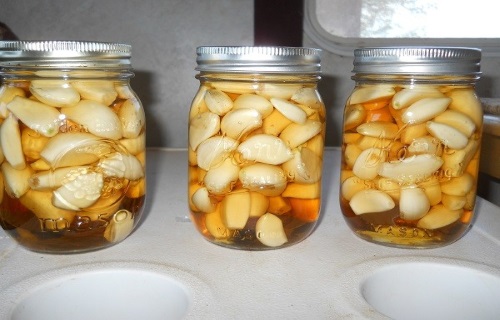
How to make fermented garlic honey; a tasty condiment with cold and flu combatting abilities, immune-boosting properties, and an impressive shelf-life; perfect for enjoying for years to come! Best of all, all you need is two ingredients and a sterilized jar!
Whether you want to consider this as fermented garlic honey or honey fermented garlic, the process and dish are the same. By combining fresh garlic with raw honey and allowing it to ferment, you end up with garlic that is sweetened and mellowed and garlic-infused honey that not only tastes good but packs a punch of health benefits too!
When it comes to garlic, in my opinion, you can never have too much. I recently posted recipes for pickled garlic and the TikTok trending spicy pickled garlic. I’ve previously shared recipes for garlic confit and garlic toum (a Lebanese garlic sauce). Now it’s the turn of this garlic fermented in honey with the ultimate shelf life.
Enjoy it when you feel a cold coming on or have a sore throat, or drizzle the honey over pizza, veggies, add into marinades and dressings, or to a whole array of other dishes (keep reading for suggestions!)
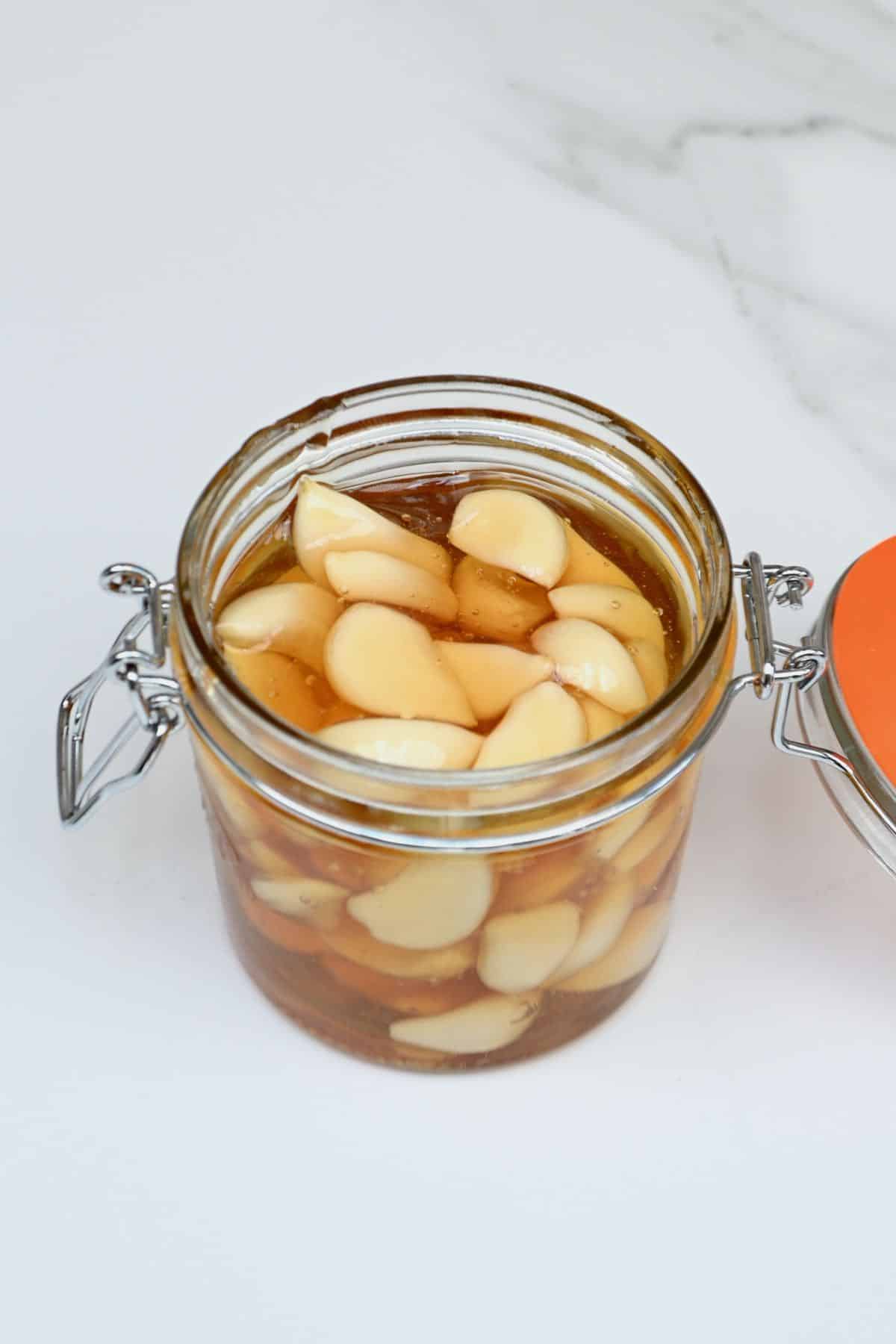
There may be a weeny bit of a learning curve when it comes to fermented products, but (in my opinion anyway), the results are worth it. Just like homemade kombucha, this fermented garlic is something I not only enjoy making but enjoy eating too (and there are so many ways to use it too!).
Not only is this honey garlic ferment shelf-stable, but unlike other methods to preserve garlic (which often carry the risk of botulism), for this method, it is improbable. The acidity of honey means that bacteria are largely unable to survive and multiply, making this honey’s shelf life potentially endless. That is if it’s stored with a tight lid on at all times when not being used.
GARLIC AND HONEY HEALTH BENEFITS
Both garlic and honey have been used for many decades (or longer) for traditional remedies. When combined, the two provide anti-bacterial, anti-viral, and immune-boosting properties. This makes this fermented garlic perfect for enjoying during cold/flu season!

In fact, the antimicrobial properties of honey make it seem like an unlikely choice for a fermentation medium. However, fermenting garlic in honey allows the garlic to release enough juices into the honey to allow for the fermentation process.
On top of the above, several studies have found that garlic may also be beneficial towards heart health by lowering blood pressure, cholesterol and preventing clotting and hardened/stiff blood vessels.
More so, the high antioxidant content in both ingredients means that it may help to protect our brains from inflammation-based diseases such as dementia and Alzheimers.
THE INGREDIENTS
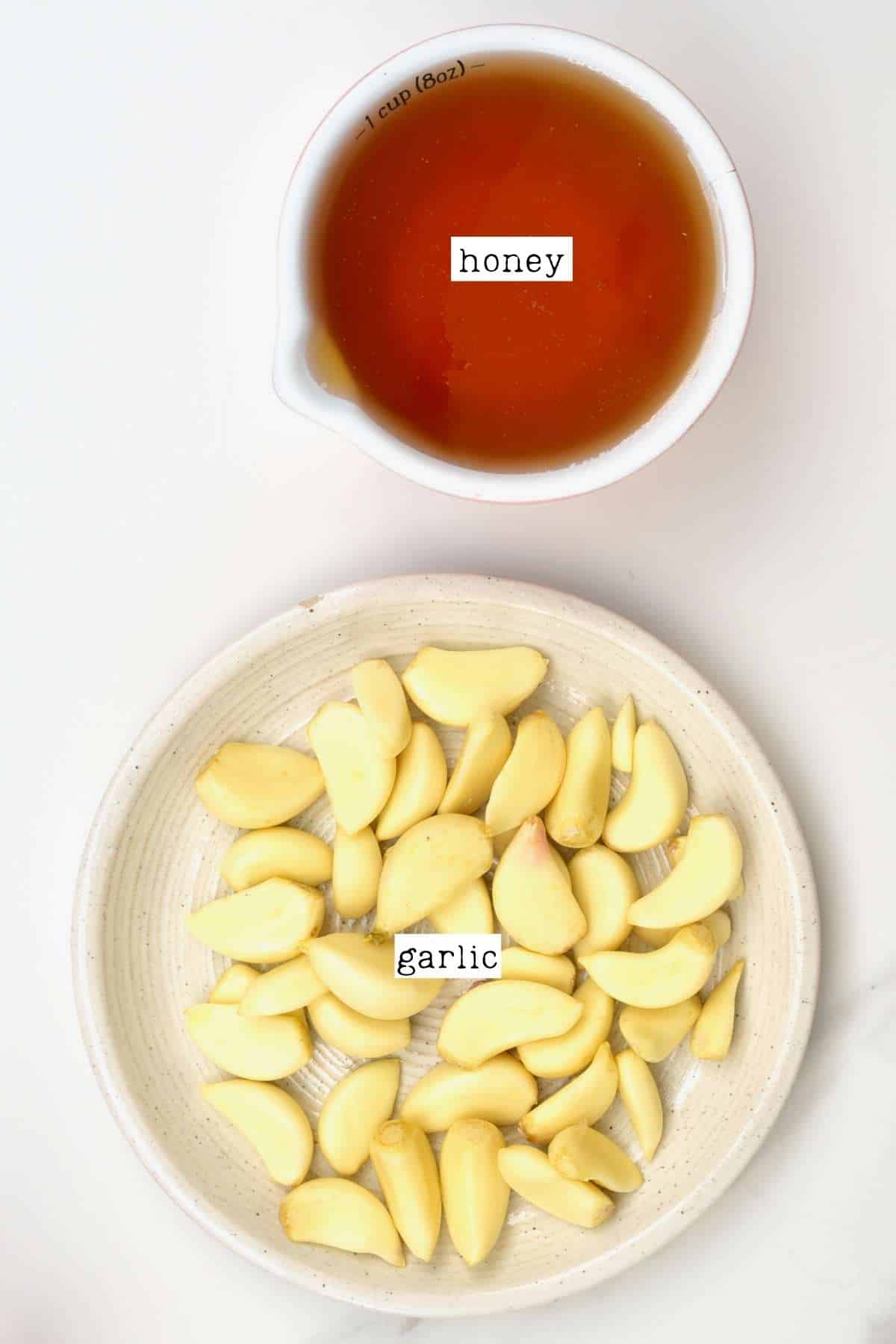
THE INGREDIENTS
- Raw honey: make sure to use raw, unpasteurized honey. The process won’t work if it’s not raw, as the microbes will have been killed off in the pasteurization process.
- Garlic: it’s best to use the freshest garlic you can find for the quickest and best fermentation results.
You may also like this chili and garlic-infused honey.
HOW TO MAKE FERMENTED GARLIC HONEY
STEP 1: PREPARE THE GARLIC
First, you’ll need to peel the garlic using one of several methods. Then transfer the peeled garlic cloves to a sterilized glass jar with an airtight seal.
It’s a good idea to lightly crush or chop the cloves in half to speed up the fermentation process. Alternatively, you could prod the whole cloves a few times – to encourage the release of their juices into the honey.
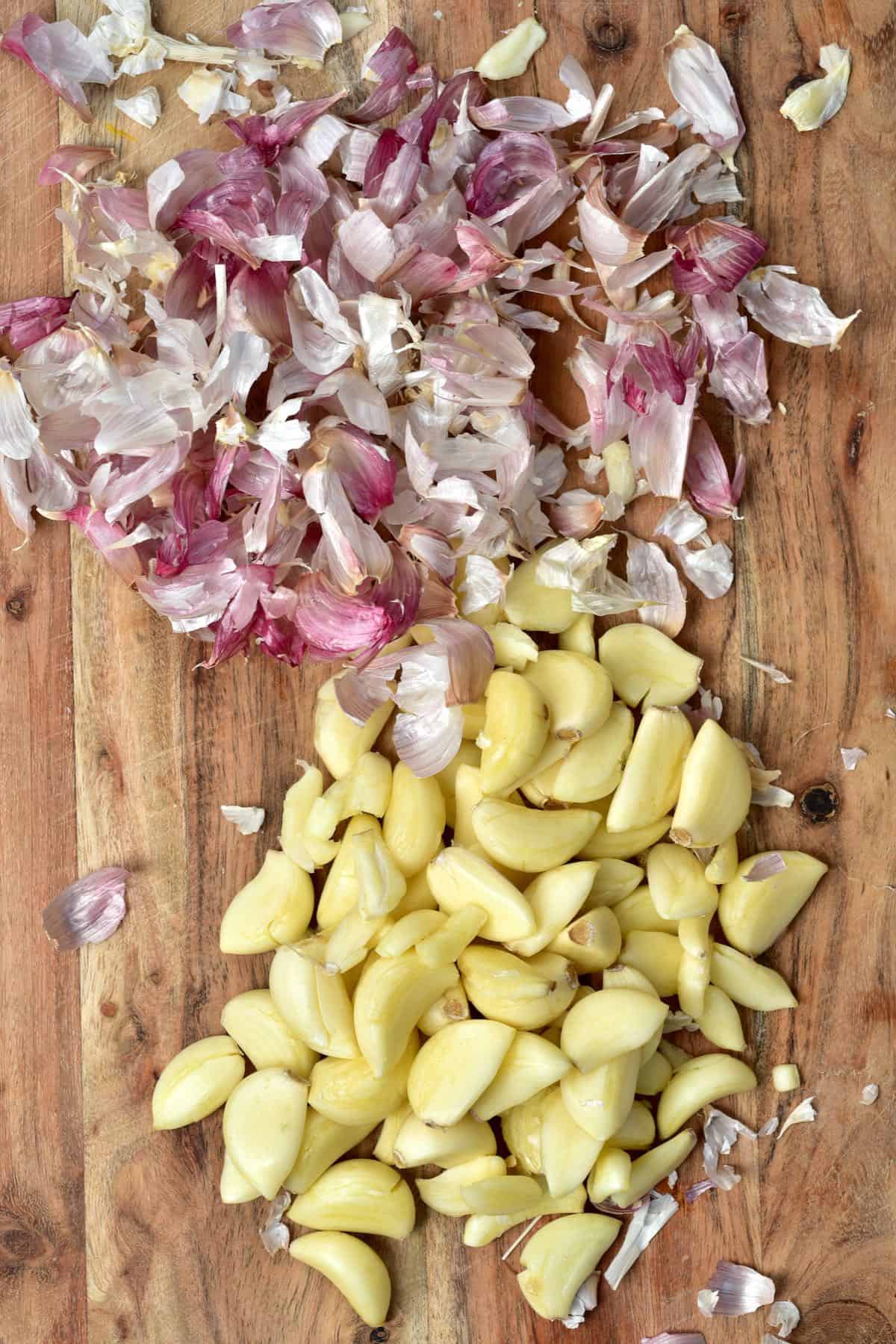
STEP 2: ADD THE HONEY AND FERMENT
Then, fill the jar with honey, mix it, and then seal it.
Once sealed, turn the jar upside down (this is why a good seal is essential) and set it aside. Place a plate beneath the jar, just in case, though I’ve never had issues with overspill/leaks.
For two weeks, you’ll need to ‘burp’ the jar daily. To do this, open the lid to allow any build-up of gases (CO2) to release and then close, shake (or stir it), turn upside down, and set aside again.
Be quick while doing this as too much oxygen introduced to the honey and garlic at this stage can impact the fermentation process. Just a quick opening of the lid should be enough to release the gases.
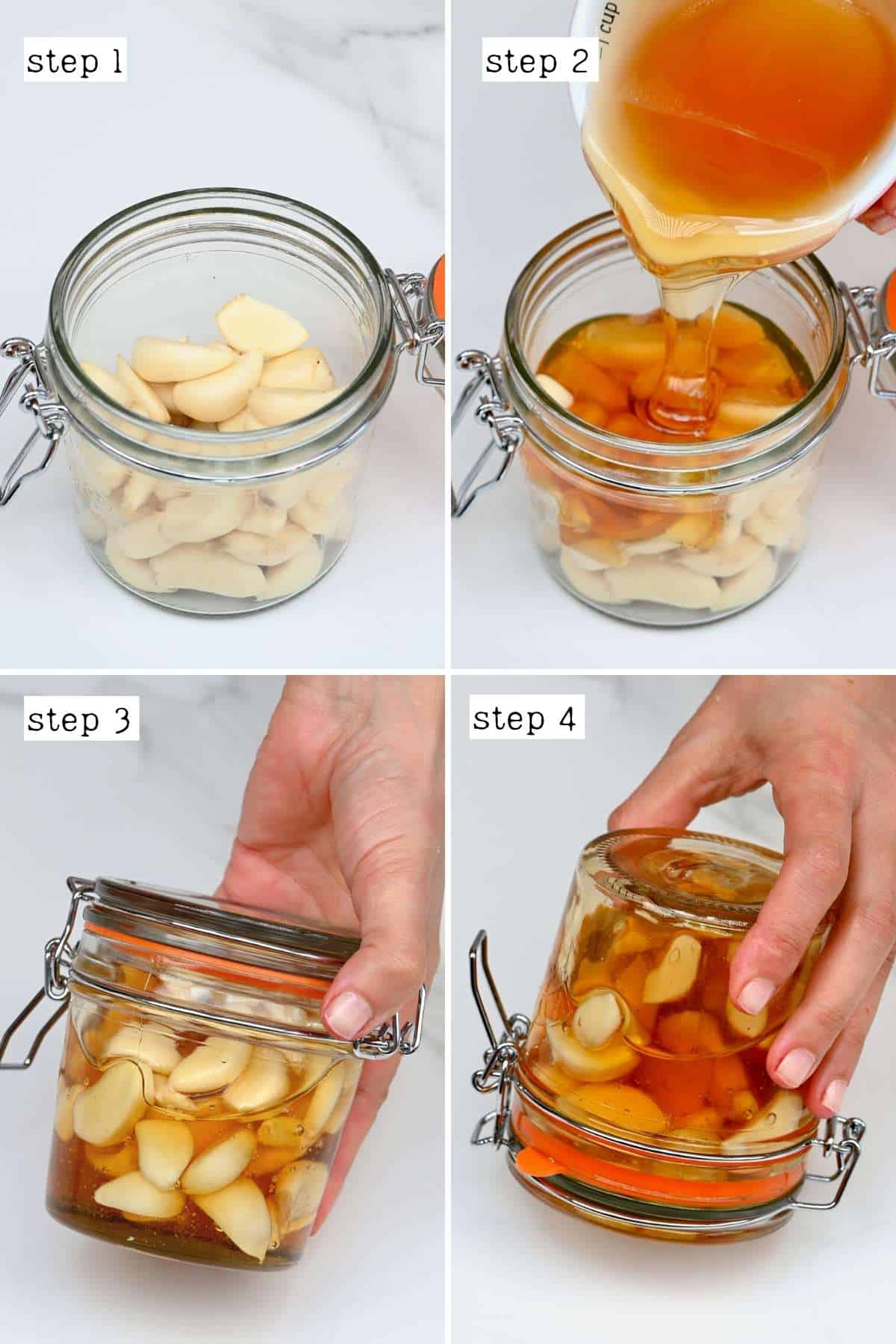
During this time, you’ll likely see “activity” in the form of foaming or bubbling within the jar. The amount can vary, and it won’t always be majorly noticeable. The honey will become more watery, too, as the garlic releases liquid into the mixture.
After two weeks, the fermented garlic is ready to enjoy, though I’d wait a month for even better results! If you don’t plan on using it very often, then it may still need burping occasionally, though the build-up of gases will slow down over time.
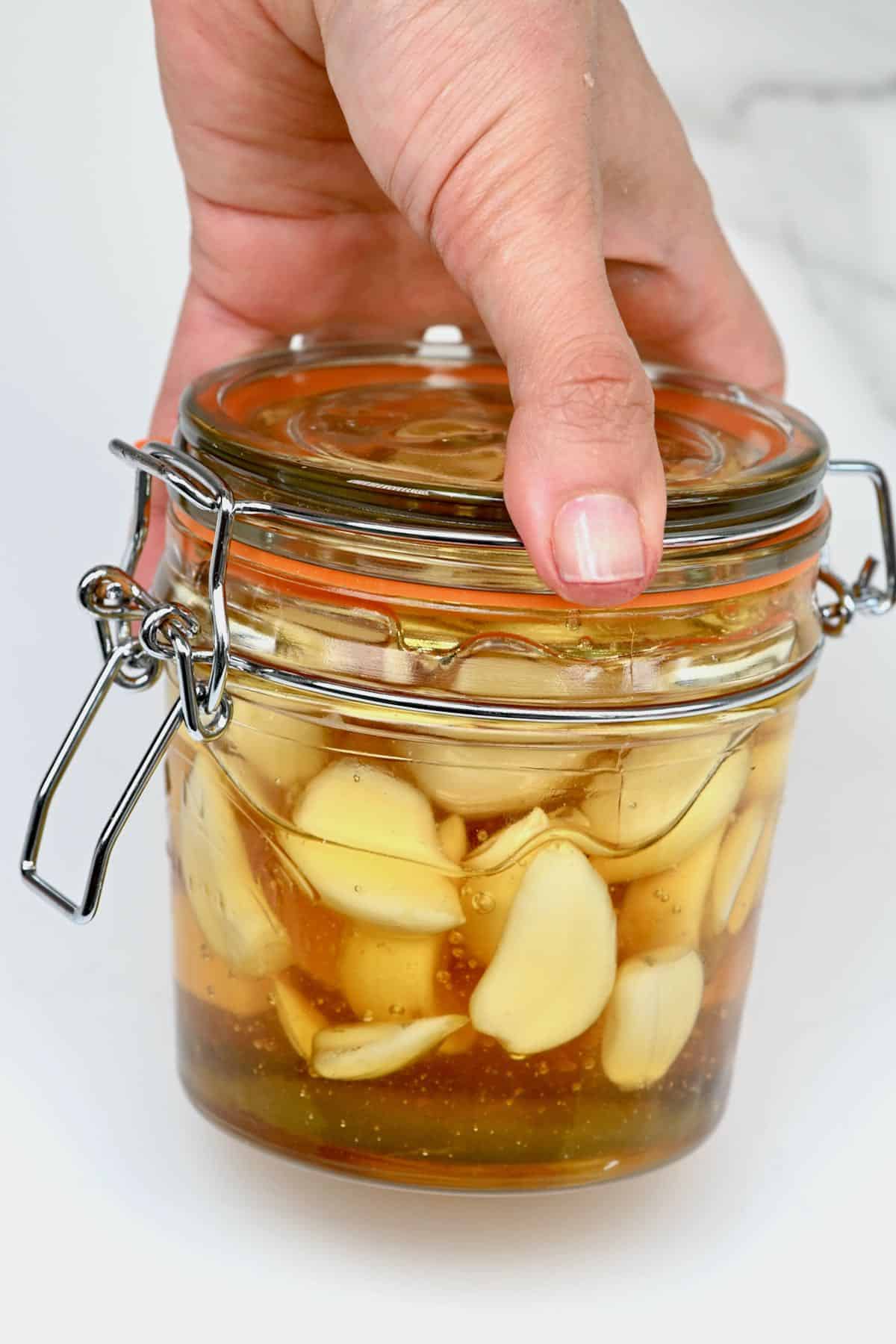
HOW TO STORE?
Store the jar of fermented garlic and honey in a cool dark location away from direct sunshine – like a kitchen cupboard or pantry. As long as you store the honey with an airtight lid and don’t allow any moisture to enter the jar, then the garlic honey can last for years!
Note that it’s normal for the honey and garlic to darken over time – it’s even normal for your garlic to turn blue/green (though this isn’t typical for a honey ferment) – it’s a natural reaction.
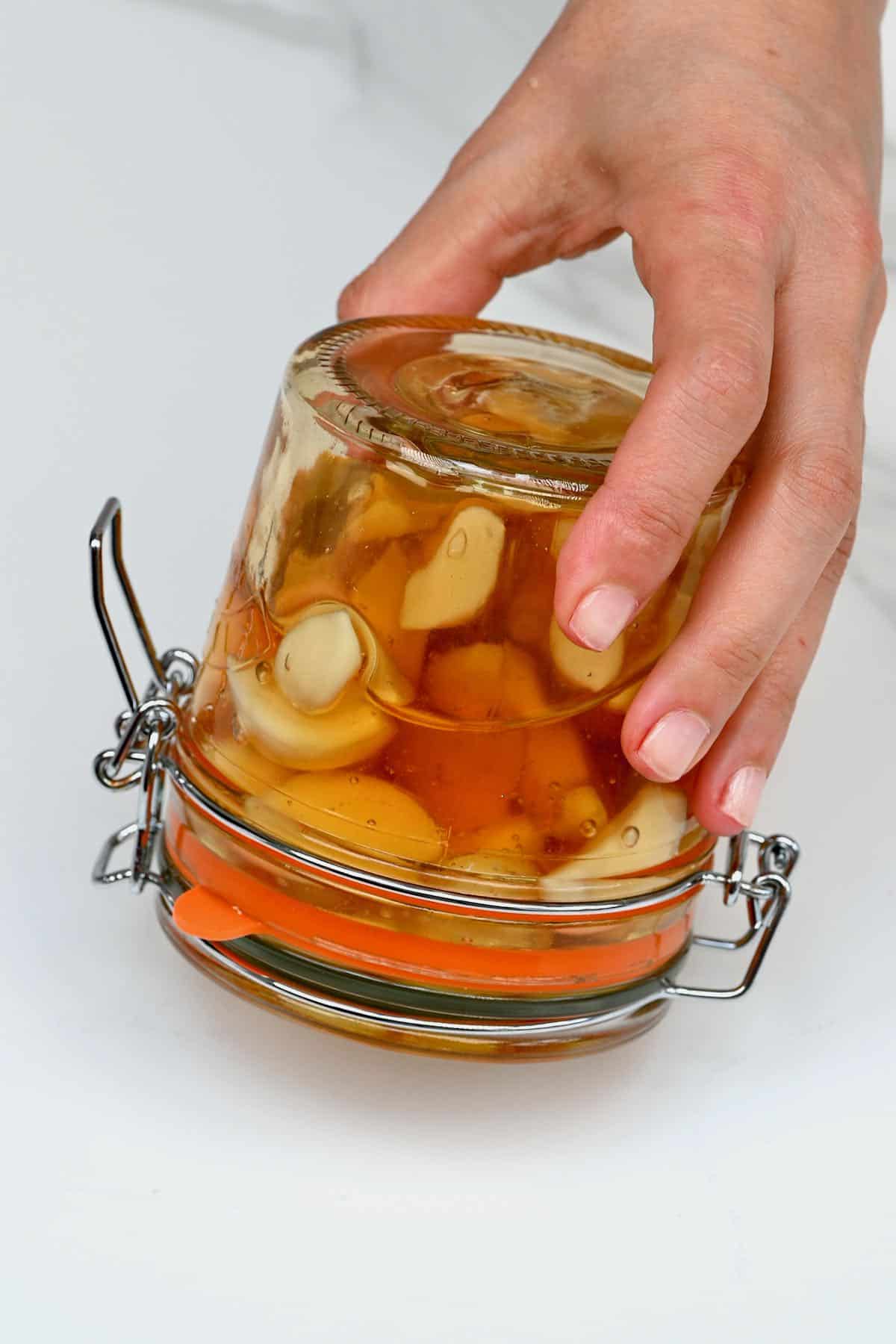
WHAT ARE THE FERMENTED GARLIC HONEY USES?

There are tons of ways to enjoy this garlic fermented in honey. Here are just a few of my top suggestions.
- Eat one of the honey-soaked garlic cloves when you feel a cold/sore throat coming on.
- Eat a spoonful of the garlic-infused honey for the same reason as above.
- Use the infused honey for salad dressings and marinades.
- Drizzle it over cheese – like goats cheese, ricotta, etc.
- Spread it over toast, cornbread, pretzels, and breakfast muffins, etc.
- Drizzle over pizza.
- Use as a glaze for your favorite protein: meat, fish, or tofu!
- Drizzle some over roasted or stir-fried veggies.
- Use the mellowed garlic in dips like hummus or this white bean dip.
Let me know in the comments how else you’d enjoy the honey, garlic, or both combined!

FAQS
Is there a risk of botulism with fermented garlic honey?
While the risk is very minimal, you can test the garlic honey mixture if you are concerned. Botulism can only survive in specific environments and acidity levels. To test this, you can use a pH strip (or monitor). Any reading under 4.6 is considered safe. If it’s slightly above that, you could add a little apple cider vinegar to the mixture to lower the pH before consuming it.
My garlic isn’t sinking, why?
Garlic can take some time to sink in the mixture as it releases its juices into the honey – usually based on how fresh it is (though usually between 1-2 months). It should eventually sink, though. The aim at the beginning is for the garlic to be covered by the honey as much as possible to prevent spoilage.
Can I use my first batch of garlic honey as a ‘starter’ for the next fermented garlic?
Unlike yogurt, where the microbes in the ‘starter’ will help kickstart the new mixture, this doesn’t work in the same way for fermented garlic honey. The fermentation process goes through several stages, and I’m afraid that ‘skipping’ some or trying to ‘hack’ it could not only impact the ferment but possibly cause food safety issues. I don’t know this for sure – but better safe than sorry!
Do I need to cut/crush the garlic?
It’s not 100% necessary, though it can help to speed up the fermenting process. This is because the garlic releasing its liquid into the honey is part of the fermentation process. If you want to have whole cloves but still ‘quickstart’ the process, you could use a fork or knife to prod the cloves a few times.
Can I use pasteurized honey for fermented garlic?
No! Unfortunately, pasteurized honey kills off all the microbes that are needed for the fermentation process to work. Please use raw, unpasteurized honey.
Can I use maple syrup instead of honey?
This isn’t something I’ve tried so I can’t say for sure. The water content within maple is quite a bit higher than honey so that will impact its shelf life. The pH level is also a lot higher than honey and so may not be safe in terms of the risk of botulism unless extra ingredients like vinegar and other acidic elements are added to reduce the pH.

RECIPE NOTES AND TOP TIPS
- To avoid manually burping the jar: you can use a self-burping bale wire jar (fido jars) or purchase jars with airlock lids or other ferment lids. Just make sure to still shake the jar to keep the garlic submerged.
- Using fermenting weights: one way to make sure the garlic stays submerged under the honey throughout is to use fermenting weights. You can buy fermenting jars that come with weights to fit those jars specifically.
- The fresher the garlic, the better: use the freshest garlic possible as it will produce the quickest and best ferment.
- Leave a little headspace: some batches may foam up more than others and cause overspill. For that reason, I always leave headspace at the top of the jar.
- The perfect fermentation period: the best time to begin enjoying your fermented garlic honey is when the main fermentation is over. It won’t be as foamy, the honey will have thinned out and started to darken, and the garlic will have sunk to the bottom of the jar. This usually takes between 4-6 weeks. Though waiting 3 months is even better. If you have the patience, I recommend waiting a year for a genuinely delicious surprise!
- How much honey to use: while it’s important to use enough honey to submerge the garlic entirely, there IS such a thing as too much honey. I recommend using around a 1:1 ratio of garlic to honey. If you use too much, then the anti-microbial properties in the honey will essentially ‘smother’ the garlic. If you want to add more honey, you may also need to add a little water to the honey to kickstart the fermentation process.

HONEY FERMENTED GINGER AND LEMON
How to make honey fermented ginger and lemon – a common combination for combatting cold/flu symptoms and tasty addition to meals, dressing, and drinks. Best of all, once prepared, this fermented lemon and ginger will last several months and the process couldn’t be simpler (even for fermenting newbies!).
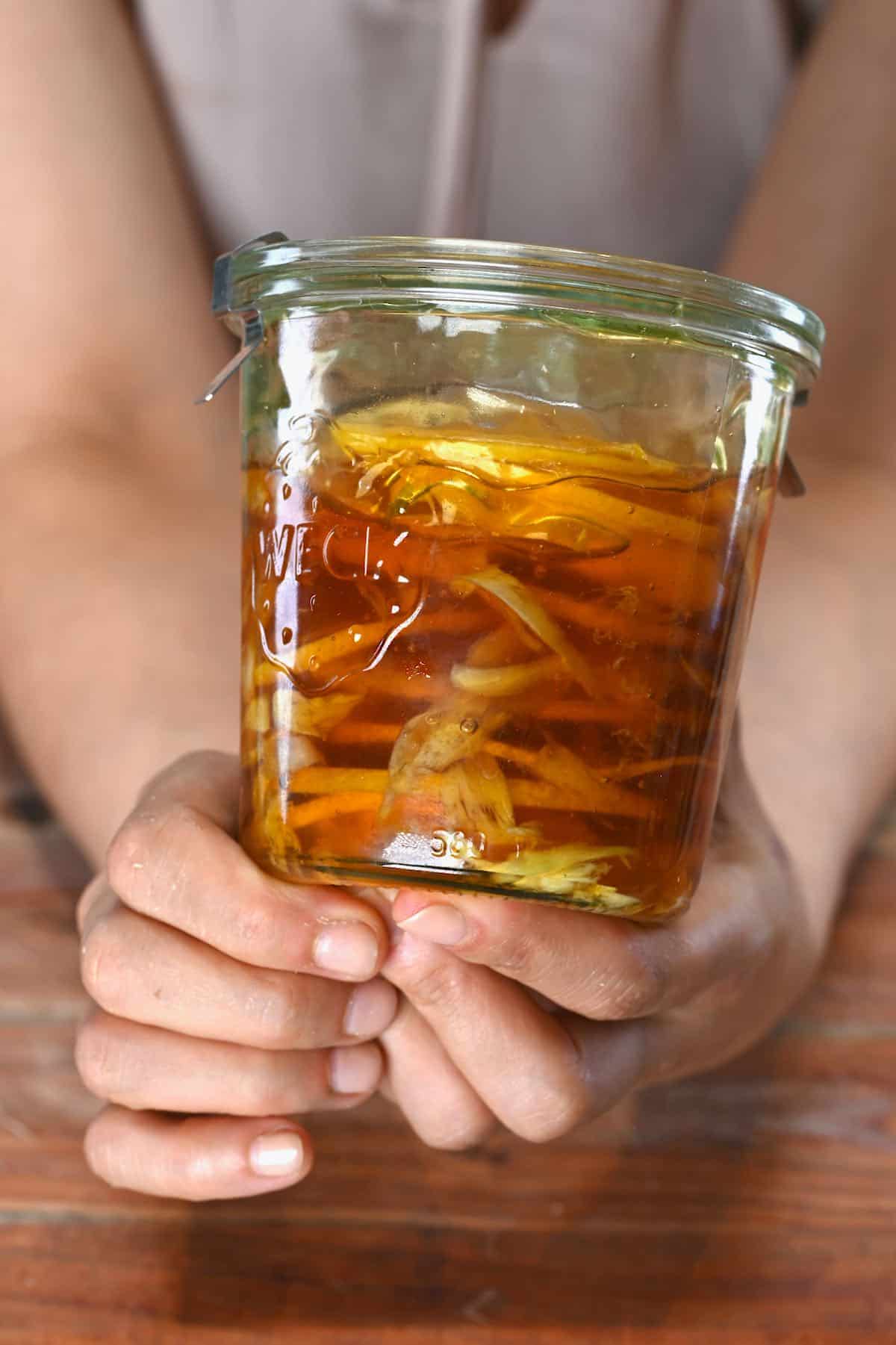
I know, if you’ve never tried fermenting before, you might be mistaken for thinking it’s a terribly technical, difficult process. While that may be true in some cases (like caring for kombucha SCOBYs), honey ferments are surprisingly simple! It’s fairly hard to “mess up”, and requires no fancy equipment/tools! I’ve already shared a method for honey fermented garlic, now it’s the turn of this honey fermented ginger and lemon!
The combination of honey, lemon, and ginger is a favorite of mine (especially for its immune-boosting properties, like in these ginger lemon and honey immunity shots). Not only does it taste great, but it makes for a great cold/flu/sore throat-busting tonic. Plus, the pollen found in raw honey may be beneficial for those with allergies. The fermentation helps to increase those benefits further too, plus it has months of shelf-life!
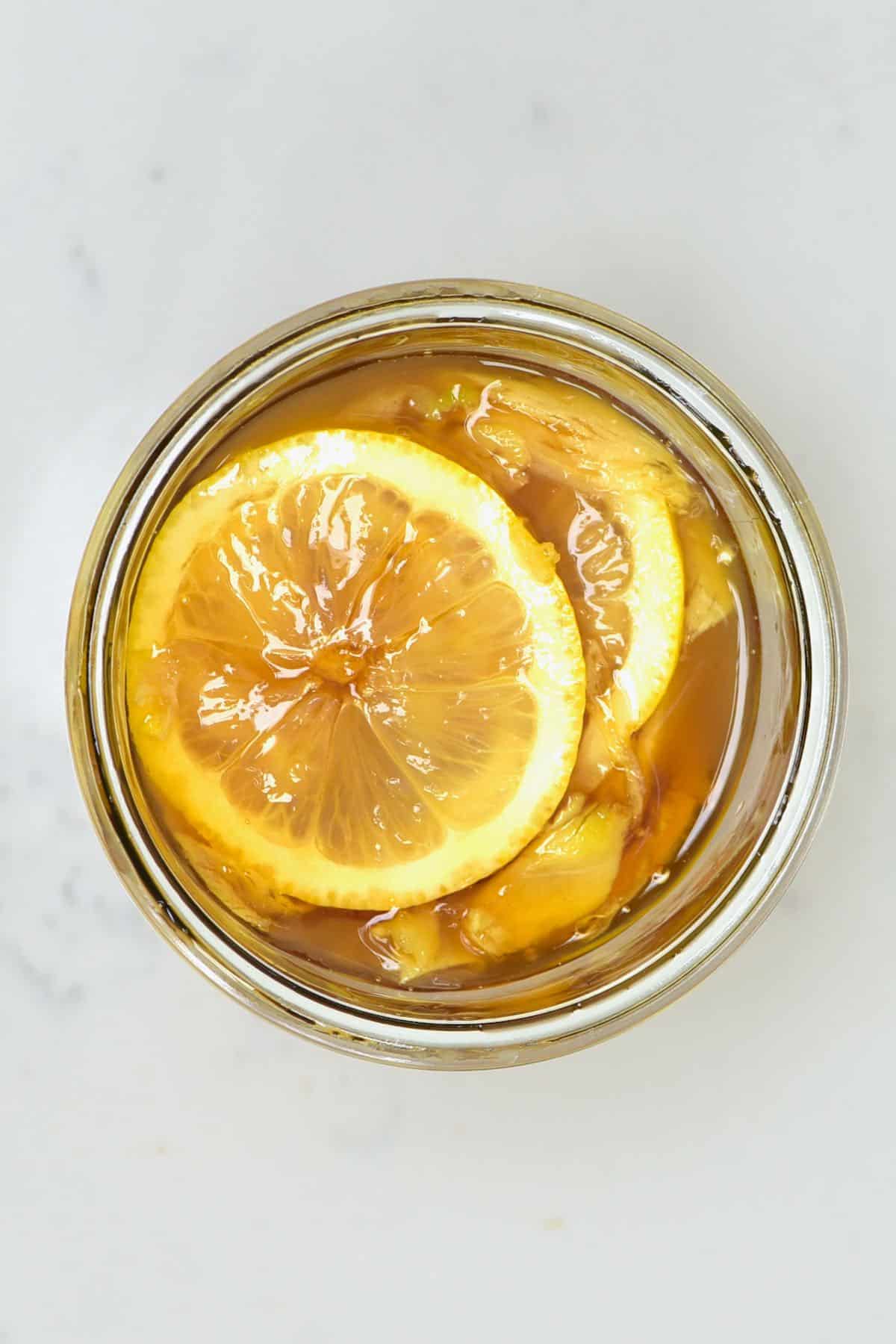
One of my favorite ways to soothe myself at the first sign of illness is to whip up a big mug of ginger tea with lemon and honey. By preparing this honey fermented ginger, you can avoid having to do this from scratch each time! However, you don’t have to be ill to enjoy this honey and lemon fermented honey either.
The combination of lemon, honey, and ginger is also a delicious addition to so many other meals, dressings, sauces, marinades, etc! (Suggestions listed below!). Looking for more ways to enjoy ginger? Why not learn how to make ginger juice, powder, crystallized ginger, syrup, or even a silky ginger pudding.
THE BENEFITS OF GINGER AND HONEY WITH LEMON
I’ve talked about the benefits of all three ingredients in several places across my blog. For example, in my post for ginger turmeric and lemon immune-boosting shots, lemon, ginger, and cayenne immunity shots, and my recently posted honey fermented garlic. So head on over to find out more there.
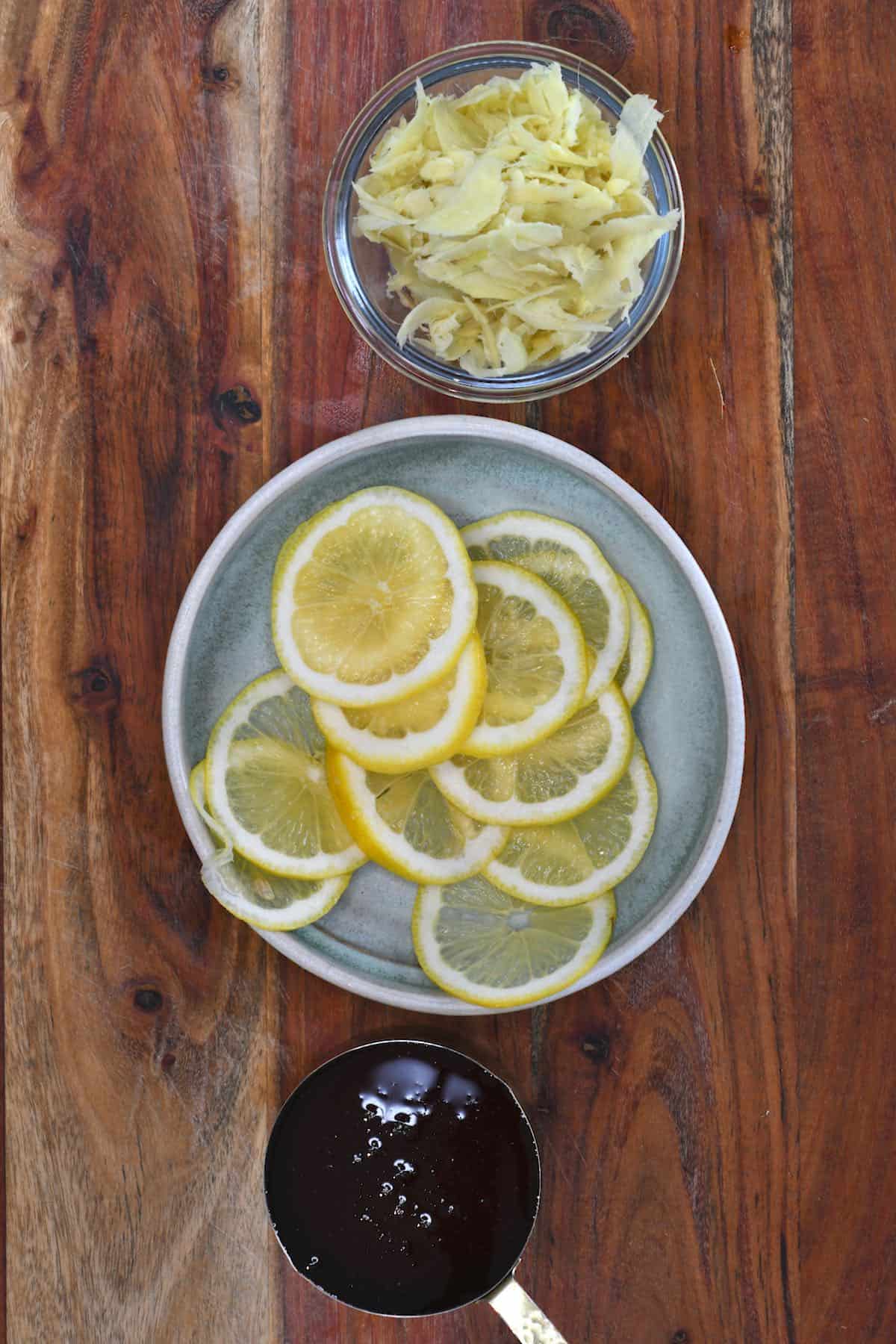
It’s important to note that all three ingredients have a very long list of potential health benefits. Ginger alone contains anti-inflammatory and antioxidant properties and is known to help remedy stomach issues and fight colds/flu while also improving brain and heart health.
Lemon is equally brilliant for your immune system and packed with antioxidants and Vitamin C. It’s also a natural detoxifier and has antibacterial and antiviral properties.
Meanwhile, raw honey boasts similar benefits including antibacterial/antiviral and antioxidant properties. It also contains gut-friendly enzymes that are good for promoting healthy gut flora and can help boost immunity and fight infection. You can read more about the top health benefits of raw honey here.
So, as you can imagine, the lemon ginger honey combination is a goldmine of health benefits!
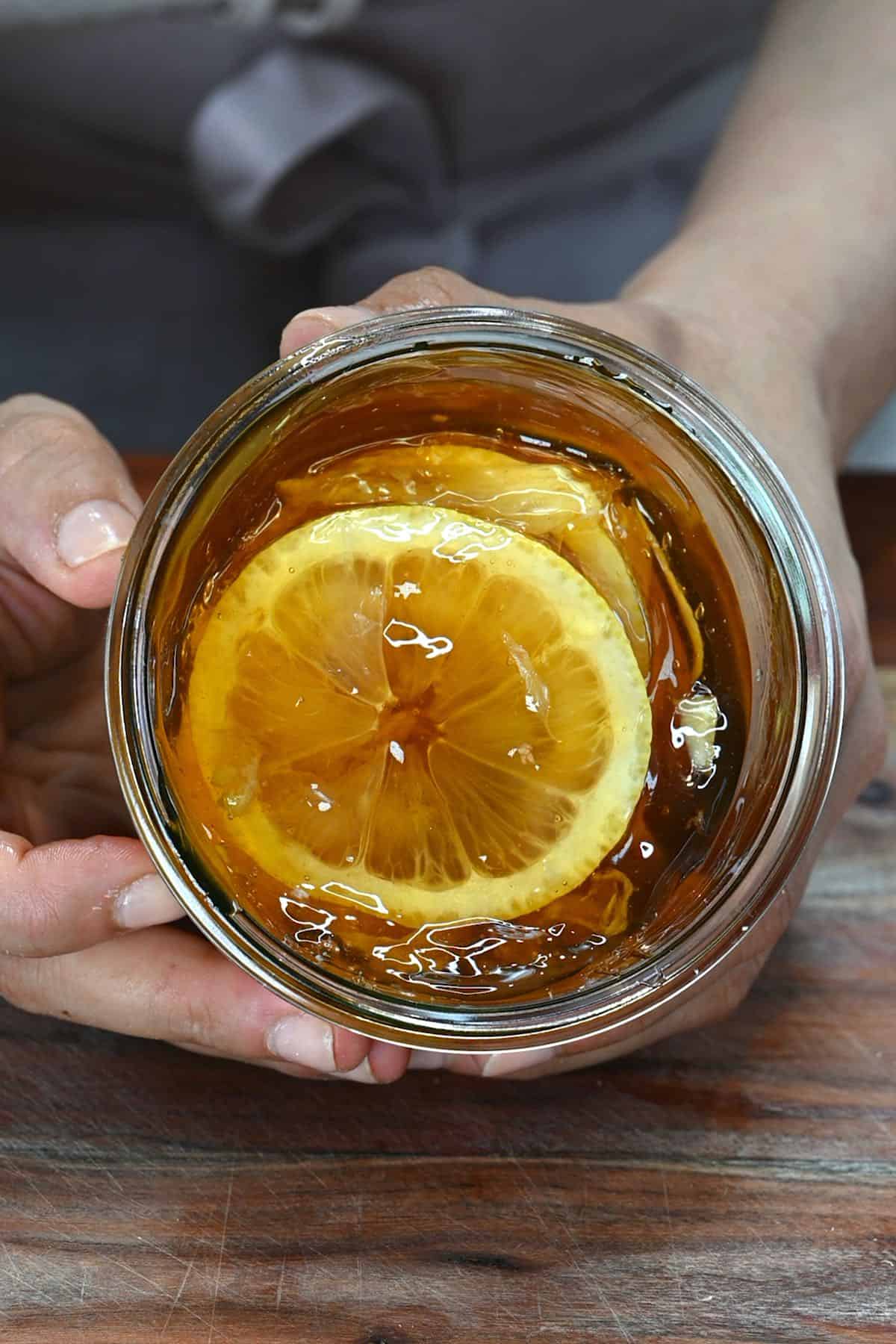
HOW DOES THE HONEY FERMENTATION WORK?

The way the fermented honey works is all down to the ingredients used. Raw honey (that’s unpasteurized) still contains the various naturally occurring enzymes and, specifically yeast. When combined with enough water to reach a moisture content of 19-20%, this kickstarts the fermentation process of the honey. In a commercial way, this is how “mead” is made, eventually.
While honey already contains around 16/17% water, the sugars in the honey pull the liquid from the ingredients placed in it (in this case ginger and lemon), which helps reach the 20% and begin fermenting. If your ingredients aren’t “wet” enough, you can top it up with extra water, too! (See I told you, easy!) This process is further helped by extra natural yeast which is found on the vegetables and fruits added to the fermenting honey.
Once the fermentation process begins, your ingredients are becoming preserved and you get a delicious fermented honey lemon ginger! Simple!
THE INGREDIENTS
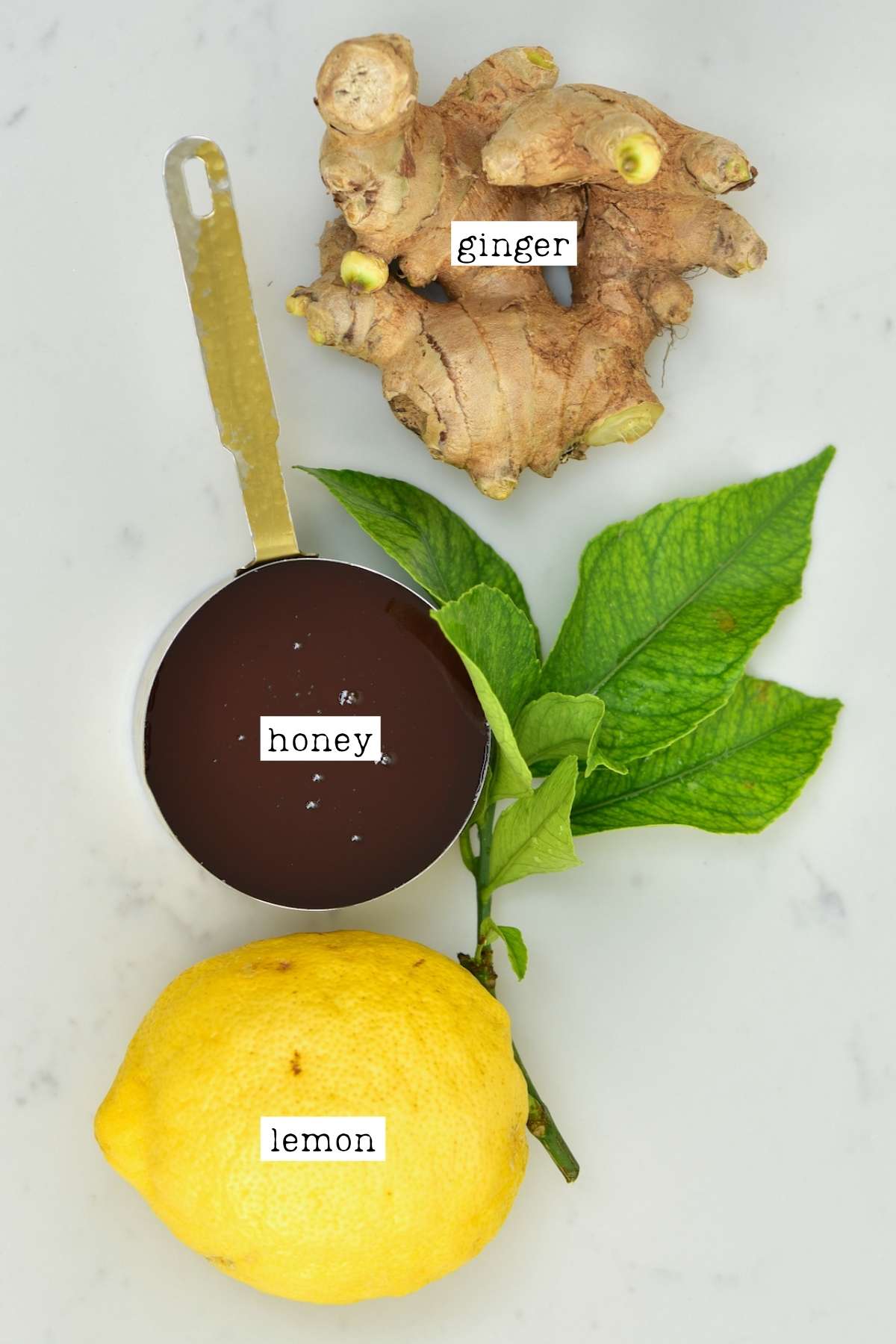
- Honey: it’s important to use raw, unpasteurized honey. Pasteurized honey won’t ferment as the microbes are killed in the processing.
- Ginger: fresh ginger, please! It’s recommended to use organic ginger, as non-organic ginger can go through processing that reduces (or eliminates) the yeast on it (that is needed to start the fermentation).
- Lemon: I include whole slices of lemon in the honey ferment, so it’s best to use unwaxed lemon! Remember that different lemons are more tangy vs sweet. If you’d prefer to use a sweeter variety, I recommend Meyer lemons. You can also use limes.
You also need a jar. Make sure to use one that is wide enough to fit whole slices of lemon and has a lid. A wooden spoon or skewer is also a good idea for mixing the fermenting ingredients (avoid metal).
HOW TO MAKE HONEY FERMENTED GINGER AND LEMON
STEP 1: PREPARE THE GINGER AND LEMON
First, sterilize the jar you plan to use for the fermented honey recipe. To do so, wash the jars and lids in hot soapy water, rinsing well. Then place the jars (no rubber or plastic parts) in a pre-heated oven for ten minutes at 325ºF/160ºC to completely dry. Some dishwashers also come with a “sterilize” setting.
Wash the lemon and peel the ginger. Then, with a sharp knife or mandoline (even better for even slices), thinly slice the lemon and ginger. I used a peeler for the ginger, but thicker knife/mandoline slices will work too.
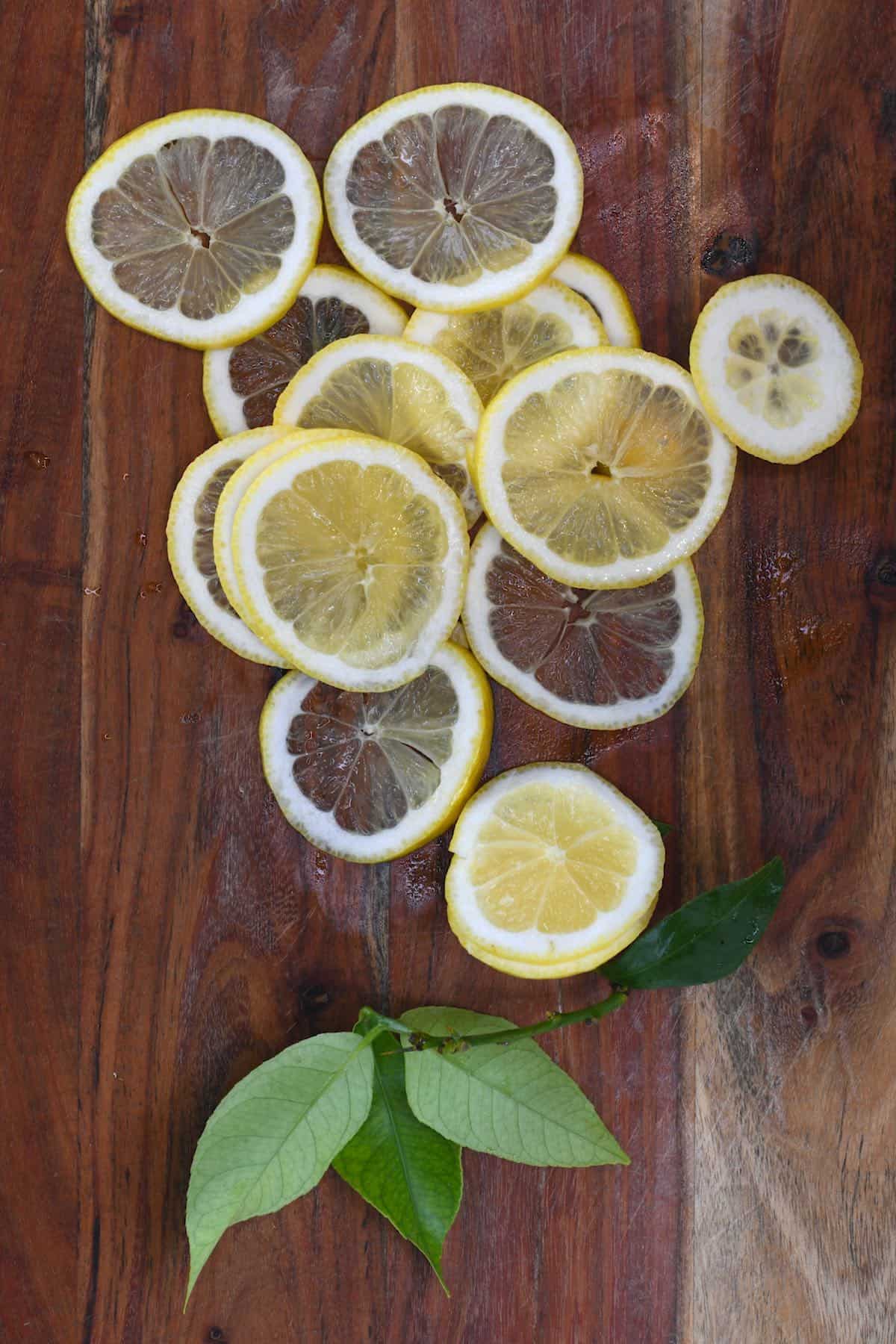
STEP 2: FILL THE JAR
To layer the jar, first place some ginger, then a couple of lemon slices. Repeat until all the ingredients are in the jar.
Then pour the honey over the ginger and lemon, making sure it fully submerges the ingredients. Also, use a clean spoon/skewer to gently shake/move the ingredients around, to make sure the honey gets to the bottom of the jar.
Alternatively, you can drizzle 2-3 tablespoon of honey at the bottom of the jar and between each layer. That way, it’s easier to make sure the ingredients are fully coated with it.
Finally, seal the jar.
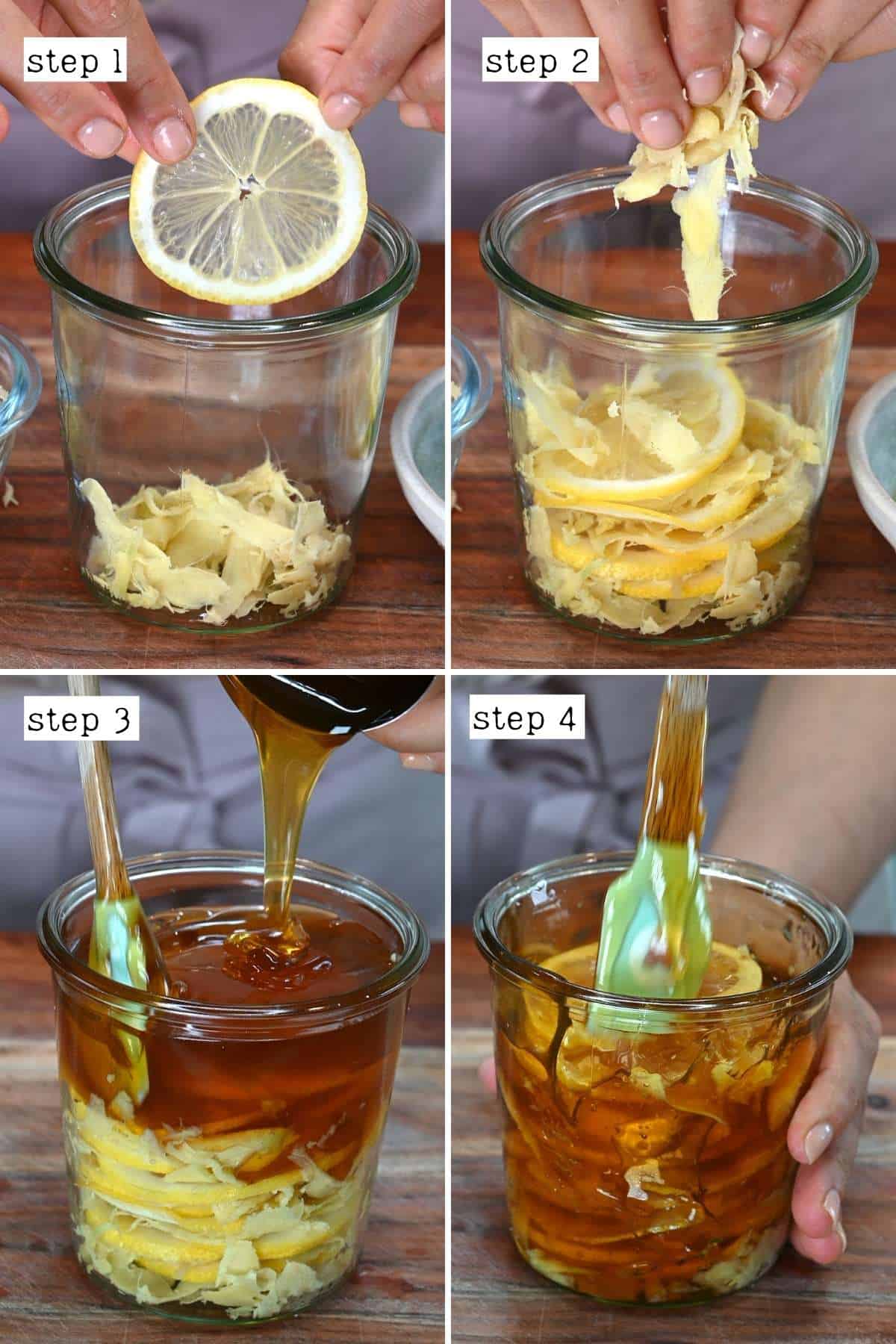
STEP 3: LEAVE IT TO FERMENT
Leave the ginger honey lemon mixture to ferment for two weeks. During this time, you’ll need to “burp” the jar daily. Open the lid for just a second to allow any built-up gases to release.
It’s a good idea to slightly shake the jar too or flip it upside down (with a plate/bowl beneath). I prefer to shake/flip rather than stir (with a wooden spoon) since an excessive amount of oxygen can impact the fermentation process.
After two weeks, you can stay enjoying the fermented lemon/ginger. However, it will taste even better at the one-month stage!
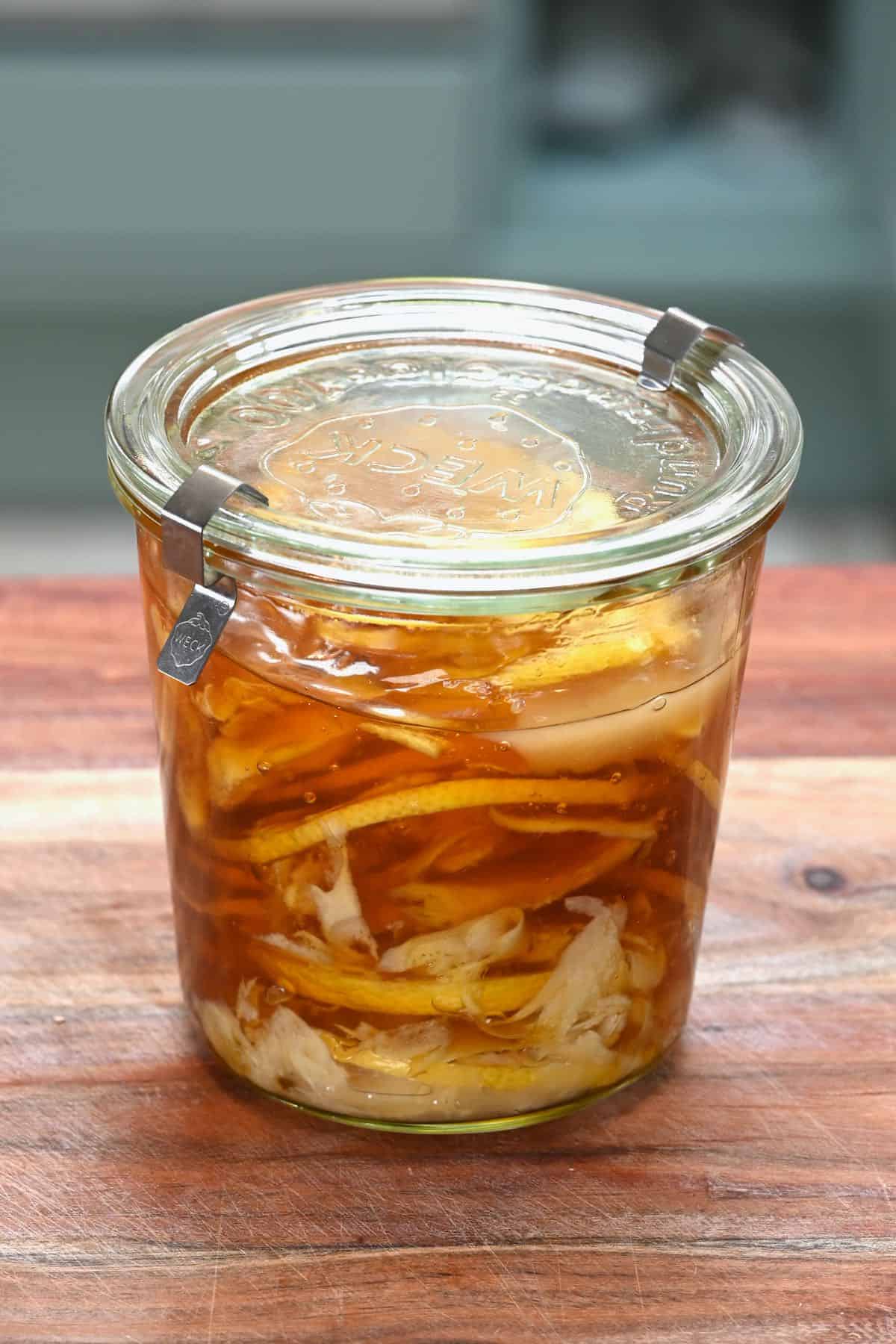
HOW TO MAKE AHEAD AND STORE
Once the fermented lemon and ginger taste as you’d like, I recommend transferring the jar to the fridge. This will slow the fermentation (almost halting it entirely) and is best for those who want to use it slowly over several months (6 months or more). You could also keep the ferment in a cool, dark location like a kitchen cupboard. This way it will continue to ferment at a faster rate and the flavor will develop and change and even become slightly boozy (like mead). I do this when I plan on using it within a couple of months.
Just note that the flavor will become more bitter over time due to the lemon pith.
Like most fermented foods, just keep an eye out for bad smells, mold, and other signs of spoilage. This doesn’t happen often, but if it does, it’s time to start a new ferment.
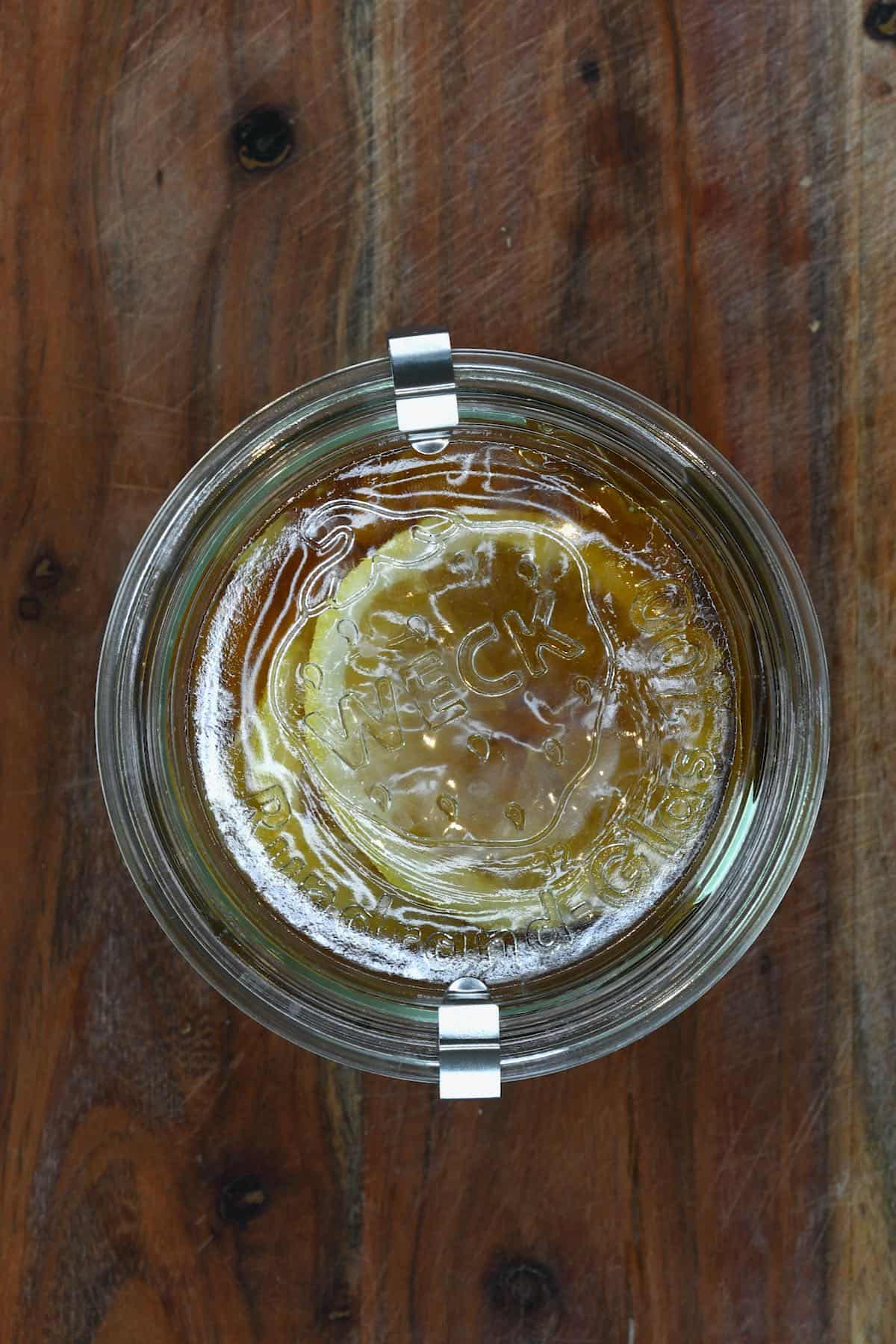
HOW TO USE LEMON AND GINGER FERMENTED HONEY?
While I know I’ve already made it clear that this concoction is perfect for when you’re feeling under the weather, there are tons of ways to enjoy this honey fermented lemon and ginger.
- Ginger tea: add around 1 tablespoon of the mixture (honey and ginger) plus a slice or two of lemon to a mug/teacup and top up with water. If you’d prefer it sweeter/more flavorful, then simply add a little more.
- Hot toddy: turn your healthful ginger tea into an adult treat with the addition of a splash of whiskey and a cinnamon stick (or a dash of cinnamon).

You can also add this fermented honey to smoothies, juices, salad dressings, and marinades.
For sweeter treats, I happily drizzle this over a breakfast bowl with yogurt (dairy or dairy-free like coconut or almond yogurt) and granola. You can also enjoy it over ice cream, drizzled over oatmeal (or baked oatmeal), over fruit crumble, pancakes/waffles, scones, etc.
Let me know in the comments how you enjoy using this honey fermented ginger and lemon!
Can I use other fruits for fermented honey?
Yes, there are all kinds of honey ferments you can make with various fruits and vegetables including apple, pear, cherries, blueberries, pomegranate, mango, peach, plum, onion, peppers, etc.
You can also use dried fruits like dates and figs. Though you’ll need to add an additional 3% water (based on the weight of the fruit), to raise the water content to the necessary level to start fermentation.The Home DoctorWhen is the fermented ginger and lemon ready?
Do you know about the gift of nature to save the life of people from various health problems and make them feel secure by curing significant issues? How to live healthy in this world without having chronic diseases or illness or any other health issues which may hurt you physically and mentally? Due to dense population, people are trying to demolish the forest, garden areas to create shelter, so they forced to destroy the nature’s gift such as natural ingredients, secret medicinal herbs and more which are grown in wild forest, mountains and other places. When you read this review entirely, sure you will get chance to know about secrets medicinal ingredients, herbs and more used by our ancestor to get back the lost health without losing your life. Claude Davis was highlighted all the stuff in the form of the e-bookThe Home Doctor filled with a list of natural ingredients and remedies that you can quickly grow in the backyard or at free space to include it in your routine diet or external usage to get well soon.
There is no cut-and-dry answer to this. Some say that when your added ingredients (lemon and ginger) have naturally sunk below the honey – which can take several weeks to a month, others say that it’s simply ready when you decide it tastes best. I tend to leave it between 2-4 weeks to ferment before starting to enjoy it. The longer it sits, the more the flavor will develop!
I recommend using a wooden spoon to give it a taste at two weeks – if you like it, transfer it to the fridge to slow the ferment. If not, keep at room temperature to further ferment for 1-2 weeks and test again.
How can I be sure the lemon and ginger are fermenting?
During the fermentation process, you should notice the honey begin to thin out and you may notice some bubbling (but not always) in the honey (of the built-up gases) and the ingredients beginning to naturally sink below the honey. If the honey has thinned but you aren’t noticing any other signs of fermentation, you may want to add 1-2 tablespoon of water, mix, and continue (as there may not have been enough water to properly encourage the fermentation). You could also add in a little apple cider vinegar which can also help kick-start fermentation, as well as bring the pH lower.
Do I need to burp the jar daily?
There is some differing guidance on this. I made sure to do this with my first honey ferment (this garlic honey ferment) when I noticed just how bubbly it became while fermenting (after having a bottle of kombucha explode in the fridge after forgetting to burp it, I’m on the “better safe than sorry” camp now).
While, technically, some say this isn’t necessary since honey ferments contain such low levels of water vs. honey (which means slower, gentler fermenting), I still like to do it daily for the first 2-3 weeks and then once a week or so after that. If you don’t want to do it daily, feel free to do it every other day (or experiment). Just beware of the potential of exploding jars if you never burp it!
RECIPE NOTES
- Burping the jar: if you don’t use the fermented lemon and ginger often, it’s a good idea to burp the jar occasionally still. After the first 2-3 weeks, the main “activity” will slow down so daily burpings aren’t necessary.
- The honey thickness: it’s important to note that the honey will become “thinner” during the ferment as the added liquid from lemon and ginger enters the honey. This is normal!
- Don’t fully fill the jar: leave some headspace for the mixture to bubble up and expand as the liquid from the ginger and lemon releases into the honey. The ingredients should be fully covered but if you add too much, the liquid content won’t reach 20%!
- Using other fruits/veg: feel free to try this fermented honey method with other ingredients. Check the FAQs for a list of suggestions.
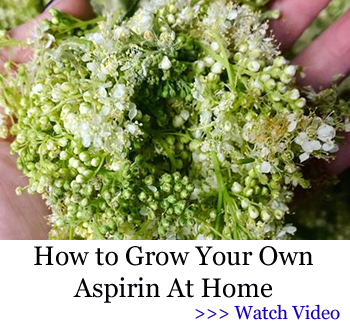
Books can be your best pre-collapse investment.
Carnivore’s Bible (is a wellknown meat processor providing custom meat processing services locally andacross the state of Montana and more. Whether your needs are for domestic meator wild game meat processing)
The Lost Book of Remedies PDF ( contains a series of medicinal andherbal recipes to make home made remedies from medicinal plants and herbs.Chromic diseases and maladies can be overcome by taking the remediesoutlined in this book. The writer claims that his grandfather was taughtherbalism and healing whilst in active service during world war twoand that he has treated many soldiers with his home made cures. )
Easy Cellar(Info about building and managing your root cellar, plus printable plans. The book on building and using root cellars – The Complete Root Cellar Book.)
The Lost Ways (Learn the long forgotten secrets that helped our forefathers survive famines,wars,economic crisis and anything else life threw at them)
LOST WAYS 2 ( Wordof the day: Prepare! And do it the old fashion way, like our fore-fathers did it and succeed longbefore us,because what lies ahead of us will require all the help we can get. Watch this video and learn the 3 skills that ensured our ancestors survival in hard times offamine and war.)
HOW TO MAKE FERMENTED GARLIC, GINGER AND LEMON HONEY - HEALTH BENEFITS - PrepperFortress
Last edited by Airbornesapper07; 06-23-2024 at 04:50 AM.
If you're gonna fight, fight like you're the third monkey on the ramp to Noah's Ark... and brother its starting to rain. Join our efforts to Secure America's Borders and End Illegal Immigration by Joining ALIPAC's E-Mail Alerts network (CLICK HERE)
-
07-10-2023, 01:29 PM #7795
Tips On Storing And Preserving Vegetables For Long Time
Amy S. June 29, 2023 No Commentson Tips On Storing And Preserving Vegetables For Long Time
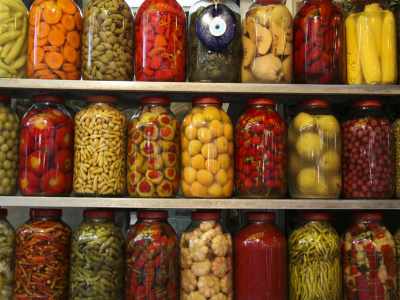
If your garden has produced a generous harvest, storing and preserving vegetables extends the bounty so you can continue to enjoy the rewards of your labor throughout the winter. There are many methods of preserving vegetables– some easy and some a bit more involved. Read on to learn the basics of a few of the most popular ways of preserving vegetable crops.
When you get a fresh, delicious vegetable from the market, it makes sense to want to cook it and use it every last bit. However, your delicious veggie might go bad before you can use it if you’re not careful.
Luckily, many techniques exist to preserve homegrown vegetables to last longer in your fridge or pantry.
REFRIGERATION
Don’t store with apples or onions; they produce gases that can cause your vegetables to rot quickly. Cold Storage is great for spinach and leafy greens, kale, broccoli and and many other cold-weather produce.
FREEZER
The freezer is a great place to store your vegetables. You can ensure they are fresh and use them later in the year when you do not have any fresh vegetables available.
- Store the vegetables in a plastic bag in the refrigerator for up to three days before freezing them.
- Freeze your vegetables in a single layer on a parchment paper-lined baking sheet
- Put individual servings of vegetables into airtight plastic, glass, or metal containers. Keep them frozen at 0 degrees F or below (32 degrees Celsius) for up to one year.

PRESERVING IN TRAYS
Freezing vegetables in ice cube trays is a great way to preserve them. In addition, you can make small amounts of stock, pureed soups and sauces, pesto and other liquids, or even freeze fresh herbs.
If you have an abundance of vegetables or fruit, you can use ice cube trays to freeze small amounts. This is helpful if you have a favorite recipe that calls for a small amount of stock or other liquid but not enough to make a whole batch. Ice cube trays are also great for freezing pureed soups, sauces, pesto, and other liquids. Finally, of course, they’re great for freezing herbs too!

COLD STORAGE (A ROOT CELLAR)
Creating a root cellar is a great way to preserve root vegetables and other preserved foods, but it’s not for everyone. It can be a great solution if you have the space and budget. But maybe you don’t have the space or money for a whole underground room!
A root cellar is a place near or adjacent to your home that’s a cool, dark place to store your vegetables in the winter. It can include an underground room or a room built into the side of your house. Most often, it’s lined with stone or brick, insulated, and has no windows or doors, so it stays dark and cool all year round.
A root cellar has drawbacks: if you live in an area with lots of humidity, mold can be a problem; they’re typically only suitable for storing root crops like carrots, potatoes, and onions, and they’re also expensive to build!
DRYING THEM (DEHYDRATING)
Dehydrating or drying food is one of the oldest methods for preserving vegetables, so you don’t have to worry about it being unsafe. In fact, drying preserves the nutrients in your veggies—so they are actually more nutritious than fresh produce!
Drying is also a great way to use leftover veggies, herbs, and fruit when in season. For example, if there’s an abundance of zucchini at your local farmer’s market right now—you can dehydrate them so they’ll last until next summer!
The easiest way to preserve fresh fruits and vegetables is using a food dehydrator. You can also dry food in the oven or in front of a fan (or outdoors). However unlikely it may sound: you can even do this at home without fancy equipment! Dehydrated foods can be rehydrated with hot water and are great for backpackers looking to travel light!
STORE IN VINEGAR
Vinegar is a liquid made from fermented alcohol. It’s an acidic liquid that can help preserve vegetables.
Vinegar is a great way to store vegetables because it protects them from mold and other harmful microorganisms but doesn’t harm the taste of your vegetables as much as salt solutions. In addition, vinegar has several health benefits! Many kinds of vinegar are made with apple cider or balsamic vinegar (which means they contain antioxidants). If you’re interested in using vinegar as an ingredient, check out this article we wrote on making your own homemade salad dressing using different vinegar!
SHORT-TERM PRESERVATION METHODS
OVEN ROASTING
Roasting them only takes a few minutes, and you can use them throughout the week.
Roasting vegetables brings out their natural sweetness and makes them easier to digest. It’s also an excellent way to make fresh vegetab.es more accessible. In addition, roasted vegetables can be used in salads, soups, stews, and more!
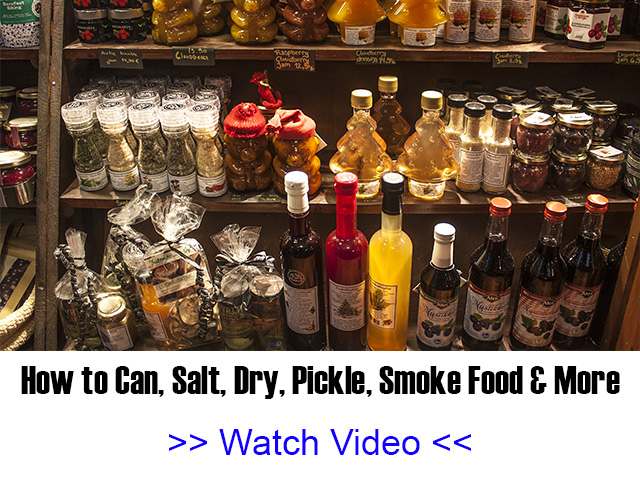
BLANCHING
Blanching is a method that involves placing vegetables in boiling water quickly and immediately moving them to a bowl full of ice and water to stop the cooking process. This process preserves the vegetable’s color, texture, and flavor while killing any bacteria that could make you sick if eaten.
LONG-TERM PRESERVATION METHODS
WATER BATH CANNING
Many home canners say that water bath canning is the easiest method and is a good option for beginner canners. The process involves placing the vegetables in jars and adding boiling water, vinegar, or lemon juice.
Glass mason jars are placed in a boiling water bath and processed for a required time. Then they’re cooled and sealed before storing them in your pantry.
PRESSURE CANNING (PRESSURE COOKER)
Pressure canning is another popular method used by many home gardeners. However, it requires specialized equipment (a pressure canner) and knowledge of food safety issues, so it’s not recommended for beginners new at preserving food.
QUICK PICKLING
The flavor of pickled vegetables is amazing and keeps their crunchy texture. You can use pickled vegetables in salads, sandwiches, or snacks.
The acidity of vinegar prevents bacteria from growing on your food. In addition, the salt draws out excess moisture from the food and helps prevent spoilage while keeping the flavor intact.
You can make pickles with any vegetable or fruit, including cucumbers, carrots, radishes, onions, green beans, and more!
FERMENTATION
Fermented foods are probiotics and are great for gut health. They help increase your digestive enzymes, improve your immune system, and decrease bloating.
The salt helps break down the vegetable cells and creates an environment where lactic acid bacteria can flourish (which makes them so healthy).
You can preserve vegetables by fermenting in a jar with water and salt (a brine) or add some salt directly to your vegetables if you don’t have time to make a brine.
Vegetables that work well for fermenting include cabbage, cucumber, carrots, beets, radishes, kimchi (Korean fermented vegetables), sauerkraut (German fermented vegetables), kimchi (Korean spicy pickled cabbage), or pickles.
LACTO-FERMENTATION
Lacto-fermentation is a simple and powerful method of preserving vegetables. The process involves adding salt to vegetables, allowing them to ferment for several days or weeks, and then refrigerating them. This method creates an acidic environment that inhibits the growth of harmful bacteria while preserving the nutritional value of the original vegetable.
HONEY FERMENTS
Fermented honey is made when raw honey is exposed to added moisture and warmth. It is full of beneficial bacteria and known to improve digestion. These fermented honey recipes use juices naturally present in produce to add moisture to kick off the fermenting process. The honey gets tastier, the produce gets tastier, and you get healthier!
Try Fermented Honey Garlic to boost your immune system next time you get sick or serve Fermented Cranberries at your next winter celebration.
This fermented honey garlic is the perfect thing to make to boost your immune system! Both honey and garlic have strong medicinal benefits, so you’ll want to have this delicious home remedy on hand for cold and flu season.
Fermented Honey Garlic Recipe
Making fermented honey garlic is so easy, it hardly needs a recipe!

PREPARE THE GARLIC
The hardest and most time consuming part is prepping all of the garlic. Whatever size jar you use, you’ll want to fill it about 1/2-3/4 full of peeled garlic.
The quickest and easiest way to prep garlic is to place the side of a chef’s knife on top of a single clove and then give it a firm whack with the palm of your hand.
Don’t do it too hard, as you don’t want to crush the garlic, but just enough to lightly bruise the it. This will make it easy to peel, and will also release a bit of the garlic juice.
ADD THE HONEY
Once you have enough garlic in your jar, pour in some raw honey to cover it. The garlic will probably float a bit and that’s ok.
It’s important to use raw honey to make fermented garlic in honey, as it will still have all the bacteria and wild yeast that is necessary for fermentation.
When liquid is added to honey, it jump starts the fermentation process. The small amount of juice from the garlic will create just enough liquid for fermentation to happen.
COVER AND FLIP
Cover the jar loosely with a lid to let the gasses escape, and put it in a dark place to ferment.
It’s a good idea to put a plate or something similar underneath the jar as it’s fermenting, as it will likely bubble up a bit and a little. It’s also important to gently turn the jar over every day or so, or whenever you think about it, to make sure that all of the garlic stay coated with honey.
Screw the lid on tightly before you do this! Then return it to it’s upright position and re-loosen the lid.
In a few days to a week you will notice some bubbles forming on the surface of the honey. Hooray!
The honey garlic will ferment for about a month, but you can eat it at any time during the process.
The flavor will continue to develop over time, the garlic will mellow, and the honey will become much runnier.
Occasionally the garlic cloves turn a blue or green color due to a reaction during the fermentation process. While it may be a bit alarming, it is not harmful and the honey garlic can still be used.
Honey garlic will store well in a cool place for many months, or even a year or longer! I’ve kept some for over two years and it is still good.
USING FERMENTED HONEY GARLIC
Now, how do you use this fermented honey garlic? That’s a good question, and it can be used in a variety of ways.
Both garlic and honey have strong medicinal properties, so it makes sense to use it as an immune booster or if you feel a cold or flu coming on.
Pop a whole garlic clove, or take a spoonful of honey (or both!).
As you can probably imagine, honey garlic also makes a wonderful food!
It’s a natural in marinades and sauces, and would make a really tasty glaze for meats or veggies. Basically anything where you would normally use honey and garlic together!
VACUUM SEALING
If you’re looking to save money on your grocery bill by buying vegetables in bulk, vacuum sealing them is an excellent way to keep them fresh. You can get a vacuum sealer for under $100 these days, and they come with loads of different attachments that make it an easy option to keep everything from fruits and vegetables to meat, fish, and cheese fresh. Here’s how it works:
Place your food in the bag you want to seal. Remove air by pressing down on the top of the bag until all air bubbles are gone or using a handheld pump that sucks out all the air from both sides of your bag (this will take some practice).
If you’re unsure if there’s enough space left for liquid expansion—and who wants an exploding jar of preserved tomatoes?—you might want to squeeze out another ounce or two before sealing up the baggie completely.
Apply pressure evenly across every inch of your sealed package using at least two hands, holding it firmly together so no leaks occur during the storage process (this will prevent any unwanted moisture buildup).

SALT BRINE
Salt brine preserving/fermentation is a simple process that you can use to store vegetables for months. Of course, you’ll need some basic kitchen equipment and ingredients, but these skills are instrumental in your back pocket when looking for ways to preserve vegetables.
As the name suggests, this method involves using salt and water to preserve produce.
Salt brine preserves vegetables by inhibiting the growth of microorganisms that cause food spoilage, as well as any bacteria that might be present in your food. The salt concentration in the brine solution will help kill most microorganisms within 24 hours of exposure.
This method works best with fresh vegetables and fruits, although it’s possible to preserve things like jams and jellies using salt brine preservation/fermentation techniques. After processing, you’ll need to ensure plenty of nutrients are left in your fruit or vegetable so it can still ferment properly!
BOTTLING IN OIL (OR VINEGAR)
Bottling in oil (or vinegar) is another great way to preserve your veggies. It works especially well with cucumbers, green beans, hot peppers, tomatoes, and other summer fruits or vegetables that don’t have much natural juice content on their own—make sure not to use too much salt when preparing them before bottling!
BRINING (PICKLE-BRINE)
Pickling is another common way to preserve vegetables. The process involves submerging vegetables in a salty solution (known as a “brine”) for several hours or days, which creates an environment too acidic for harmful bacteria but perfect for preserving the nutrition of your veggies without compromising their flavor.
SPROUTING (MICROGREENS)
The last method we’ll cover here is sprouting—soaking seeds overnight before planting them in the soil so they can germinate faster than usual. Sprouts are incredibly beneficial for health because they contain vitamins and minerals!
It’s important to remember that the best way to preserve your vegetables is by using home food preservation techniques that work best for you and your family. The more you know how to do this, the more likely you will be to keep a steady supply of fresh food year-round!
Info about building and managing your root cellar, plus printable plans. The bookon building and using root cellars – The Complete Root Cellar Book.
This book takes a fresh look at the art, science and romance of building and stocking a root cellar. There are detailed, illustrated construction guides for making four different kinds of root cellars that are functional and attractive. These include never-before-seen models for apartment and condo dwellers and home owners without a basement.
The Complete Root Cellar Book provides technical information on using photovoltaics (solar cells) and other energy technologies to enhance a root cellar’s performance and ecological sustainability. It also includes must-know information on how to choose, store and manage a supply of fruits, vegetables, nuts and preserves.

Books can be your best pre-collapse investment.
Carnivore’s Bible (is a wellknown meat processor providing custom meat processing services locally andacross the state of Montana and more. Whether your needs are for domestic meator wild game meat processing)
The Lost Book of Remedies PDF ( contains a series of medicinal andherbal recipes to make home made remedies from medicinal plants and herbs.Chromic diseases and maladies can be overcome by taking the remediesoutlined in this book. The writer claims that his grandfather was taughtherbalism and healing whilst in active service during world war twoand that he has treated many soldiers with his home made cures. )
Easy Cellar(Info about building and managing your root cellar, plus printable plans. The book on building and using root cellars – The Complete Root Cellar Book.)
The Lost Ways (Learn the long forgotten secrets that helped our forefathers survive famines,wars,economic crisis and anything else life threw at them)
LOST WAYS 2 ( Wordof the day: Prepare! And do it the old fashion way, like our fore-fathers did it and succeed longbefore us,because what lies ahead of us will require all the help we can get. Watch this video and learn the 3 skills that ensured our ancestors survival in hard times offamine and war.)
Tips On Storing And Preserving Vegetables For Long Time - PrepperFortress
If you're gonna fight, fight like you're the third monkey on the ramp to Noah's Ark... and brother its starting to rain. Join our efforts to Secure America's Borders and End Illegal Immigration by Joining ALIPAC's E-Mail Alerts network (CLICK HERE)
-
07-10-2023, 01:31 PM #7796
Native American Gardening Techniques – Learn How Foods Were Grown in the Past
Amy S. June 22, 2023 No Commentson Native American Gardening Techniques – Learn How Foods Were Grown in the Past

Many people who are interested in green living are turning to Native American gardening techniques to learn how foods were grown in the past. Native Americans had to survive on what they grew, as well as what was available in the wild, for their survival. Some of the techniques that they used in the past are still used successfully today.
No chemical Growing
Organic growing is something we can find out a lot about now. Many people across the world, in a variety of environments, grow vegetables organically, with no chemical fertilizers. And of course, our forebears did this too. It is a case of working with what you have. For example, human urine, which is sterile, is a well known fertilizer of vegetable plants as it is full of nitrogen and potassium. Giving your plants a personal watering does them a lot of good. On the subject of urine, compost toilets are an excellent idea and building one should be top of your agenda of things you need to know how to do. A compost toilet basically, composts your own waste products, which takes around 6 months. Once composted the resultant mulch can be used for plant food and as a way of controlling water loss from the soil.
Gardening the Native American Way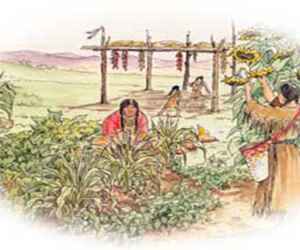
Native Americans used many of the techniques that we use today in our gardens. For example, corn or maize was grown in rows because it made pollination easier. Beans that couldn’t grow without a trellis were trained on poles or cornstalks. Gardens were often fertilized with fish from nearby creeks or rivers and today we use bone or fish meal for the same reason.
Three Sisters
One of the most often used Native American gardening techniques was the Three Sisters. This method used three different seeds planted together in one large mound of dirt. The seeds were corn, squash and beans. Each of these seeds would provide something that the other seeds would need as they grew. The beans would provide nitrogen to the soil, which the corn and squash would need to grow strong. The corn provided a trellis on which the beans would grow. The squash provided cover for the other two plants as they were growing and helped to deter some pests. Some Native Americans would also put a fish or eel in the hole first, and then place the seeds on top before covering with soil. This provided added fertilizer to the soil.
It is interesting to note that the growing of the Three Sisters varies in the east and west. In the west, the bean varieties cultivated were often self-supporting, so they did not have to be planted in the same hole as the corn and squash.
Four Sisters
Some of the southwest tribes also planted a “fourth sister” in addition to corn, beans and squash. They also planted the Rocky Mountain bee plant, which helped to attract bees to pollinate their gardens.
Jerusalem Artichoke
The Jerusalem artichoke, also known as the sunchoke, is a perennial sunflower that has edible tubers. Native Americans ate them mashed like potatoes. It was also used as a thickening agent in soups and stews. They were grown along dried river bottoms and in fertile loam soils so that the tubers were easy to dig up once mature. They were grown, and still are today, in the northern third of the United States.
Wild Rice
Wild rice was an important part of the American Indian diet. It was grown in Wisconsin, Minnesota and parts of the Great Lakes. Wild rice needs three to eight feet of water to live in. It depends on consistency in the weather and water levels in order to survive.
Women would go into the water several weeks before the rice was ready to be harvested. They would tie the rice into small sheaves, which kept the rice kernels from falling into the water when they ripened. Today, as in the past, the rice is collected in canoes. While several people paddle a canoe, one person sits at the stern and uses long wooden poles to knock the rice grains into the canoe and then the plants are allowed to spring back into place. Some grains are always left behind on the plants so that they re-seed for the following year.
Grown Herb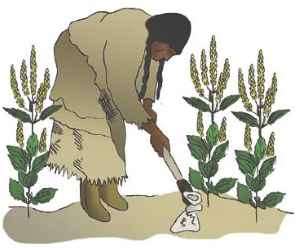
Most local garden centers sell commonly grown herb seeds and transplants ready to grow in the garden. If selecting herb seeds, you can start the seeds in a seed-starting container and transfer to the garden once propagated, or you can plant the seeds directly into the garden and thin the seedlings once they sprout. The plant tags or seed package gives all the necessary information on mature plant size and any growing requirements. Some commonly found and grown herbs include:
Sweet basil: Sweet basil (Ocimum basilicum) is an aromatic and a hardy annual herb used in many culinary dishes. It makes an attractive addition to containers or grown directly in the garden and can grow over a foot tall at maturity. Use the leaves fresh or dried.
Coriander/Cilantro: Coriander and cilantro (Coriandrum sativum) both come from the same aromatic annual plant. The leaves are cilantro and the seeds are coriander. For the best taste, use the leaves while young. Flowering occurs during summer and then the production of seeds happens.
Cumin: Cumin (Cuminum cyminum) is a small-growing annual herb belonging in the parsley family and needs a long period of warm weather to produce the flowers and seeds used in culinary dishes. Once the seedpods turn brown, they are ready for harvesting and using.
Dill: Dill (Anethum graveolens) has various uses in flavoring culinary dishes like dill pickles. The annual resembles fennel in its growth habit and description. Use the tops, foliage and stems fresh or dried. Dill doesn’t always transplant well, so starting seeds directly the garden and thinning to 12-inches is best.
Lemon balm: Belonging in the mint family, lemon balm (Melissa officinalis) performs as a hardy perennial growing up to 2-feet tall and wide. Its lemony-scented foliage and young stems add flavor to beverages and foods. Use the foliage fresh or dried.
Mint: There are several commonly grown mints (Mentha spp.), that are robust perennial growers in the garden. Peppermint (Mentha piperita) and spearmint (Mentha spicata) are two low-growing types you are most likely to find in garden centers. Plants produce runners and can quickly become invasive, so to keep the plants under control, you might want to plant them in containers. The small leaves and flowers used dried or fresh, flavor beverages and foods.
Oregano: Another relative of mint, oregano (Origanum vulgare) is a hardy perennial. It works well used in containers or grown directly in the ground. The foliage is aromatic and used fresh or dried to flavor foods.
Rosemary: Rosemary (Rosmarinus officinalis) grows as a tender perennial shrub that can reach up to 6-feet tall and wide at maturity. It belongs in the mint family and makes an aromatic addition to herb gardens and is drought-tolerant once established. Its flowers, stems, and leaves have various culinary uses both fresh and dried.
Sage: Belonging in the mint family, sage (Salvia officinalis) grows as a perennial, but many gardeners grow it as an annual herb. Its grayish foliage is an eye-catching and aromatic addition grown among green-foliaged herbs. It usually produces purplish flowers in summer during the second year of growth. Use the leaves fresh or dried in various culinary dishes.
Thyme: Thyme (Thymus vulgaris) is a perennial herb often grown as an annual. This member of the mint family has a shrubby habit, producing smallish, greenish-gray foliage and purple flowers, both of which are useable dry or fresh. The herb is well-suited for potted growth and tolerates drought once established.
SEED SAVING
At one time, seed saving was a necessity. Gardeners and farmers carefully selected and stored the best seeds from their harvests, ensuring they had seed for planting in subsequent years. The knowledge of pollination, purity, harvesting and storage of seeds was all part of survival and learned within the family and community.
The rise of commercially available seed resulted in a trend away from seed saving. Farmers and gardeners simply purchased new seed every year. Growing concern regarding the loss of commercially available seed offerings however, led to a grass-roots movement in the late 70’s and early 80’s dedicated to seed saving.
Today, recognition of the importance of crop genetic diversity is exemplified by the many local, regional and national efforts devoted to conserving the heirloom, traditional varieties that were once so prevalent. For both home gardeners and seed bank operators, the fundamentals are the same in terms of saving seed and maintaining purity. What follows are some basics to get you started saving seeds.
SEED HARVESTING
How plants are harvested depends somewhat on whether you’re trying to maintain a variety ‘as is’ or are selecting for certain traits. If you’re trying to maintain a variety ‘as is’, save seed from as many individual plants as possible, even if only 1 seed per plant. If seed matures over a period of time, save seed from multiple harvests so that seeds from early- and late-maturing plants are included in the sample. This helps ensure that genetic diversity will be maintained in your seed sample. On the other hand, if you’re actually selecting for certain traits, only save seed from those plants that express the desired trait.
TIMING OF HARVEST
When to harvest depends slightly on whether the seeds are produced in ‘dry’ or ‘wet’ fruit. Examples of ‘dry’ fruit include chiles, beans, black-eyed peas, gourds, okra, amaranth, sunflowers, corn, peas, garbanzos, cotton, most greens and herbs, sorghum, tobacco, and wheat. These should be harvested when the fruit/seeds are dry. When the seeds rattle in their pods or have begun to fall from the plant, they are typically ready to harvest. They can be left in the field until completely dry or harvested and placed in a protected area to finish drying.
Examples of ‘wet’ fruit include melons, watermelons, squash, tomatillo and tomato. These should be harvested when the fruit are slightly over-ripe but are not rotten. For vining crops, the fruit are typically mature when the fruit are somewhat whitish on the bottom side and the tendrils on the fruit-bearing stem and two adjacent stems are dry. The fruit are typically split and the seeds are scooped out of the fruit, washed and allowed to dry on cloth towels or pillowcases out of the light and heat.
The following are typically mature, and therefore ready to be harvested, when dry:
Amaranth – cut seed head when majority of flowers feel stiff to the touch, continue drying in a paper bag, pillowcase or on a metal tray to collect seeds that drop.
Beans/Black-Eyed Peas/Peas/Favas/Lentils/Tepary Beans – pods should be dry and can be picked by hand or by cutting the plant at ground level, letting dry on a tarp out of the rain and threshed.
Chiles – allow chiles to dry on the plant, hand harvest.
Corn – harvest sweet corn just after the milk-stage in the kernels (milk-stage is when a finger nail pressed into a kernel produces a white, milky liquid); sweet corn left too long on the plant may begin to ferment in the husk; for other corns, the cobs may dry completely on the plant, unless frost is likely or birds become a problem; remove entire cobs from plant.
Gourds – allow to dry on the vine until just before first frost, then continue drying out of the rain; can take several months; gourds are dry when seeds rattle.
Okra – let dry on plant but harvest before fruit opens allowing seed to drop.
Sunflowers – let dry on plant as long as possible, protect from birds by covering seed heads with netting or pillowcases; cut heads and let dry in a cool, dry place or in paper bags.
Melons, watermelons and squash are typically mature and ready to be harvested when the tendrils are dry on the fruit-bearing stem and the two adjacent stems. Some crops require a period of after-ripening in order for the seeds to fully mature. After harvesting, allow squash to after-ripen for 21 days before removing seeds.
SEED CLEANING
Seeds must be cleaned before they can be stored. Different crops require different techniques for cleaning. Overall, seeds should be free of plant material (bits of leaf, stems, etc.) and bad seeds (non-viable, broken, split, etc.).
Download printable instructions for cleaning dry processed seeds here.
Some common techniques for cleaning seed include:
Threshing – break up plant material (including fruits or pods) and expose the seeds by stomping, beating, crushing, etc.
Winnowing – separate plant material from seed with a gentle fan or light wind, leaving only clean seed.Tarp/fan – slowly pour threshed seeds in front of a fan placed near a tarp, heavy seeds fall onto tarp while the light-weight plant debris is blown farther away.Hand-cleaning – remove plant debris by hand.Blending – some wet processed seeds can be cleaned by blending fruit in a blender; add water and ‘float’ debris off the top as water is poured off slowly; repeat filling and pouring water off until only clean seeds remain (bad seed and plant debris floats to the top and is poured off with water; good seed sinks). This works well for tomatillos, tomotoes, chiltepines, and small chiles.
STORING SEEDS
Seeds can last for quite a long time when properly stored. Under frozen conditions, such as in any household freezer, many seeds will last 10 or more years, easily. While seed longevity under any storage condition is primarily dependent on the quality of the seed going in, there are certain conditions that lend themselves to longer seed storage time frames:
Storage containers should not allow moisture to enter, nor to build up inside.
Use glass jars with lids, metal trash cans, envelopes or bags, plastic ziploc bags.
Store seed in a dark, cool, dry place such as a root cellar; paper bags in a closet; do NOT store in outside sheds.
Optimal seed storage conditions – 45-55 degrees with ~25% humidity
The International Seed Saving Institute offers online instructions for saving a variety of seeds. They classify techniques into three categories: 1. beginner (bean, lettuce, pea, pepper, tomato), 2. experienced (corn, cucumber, muskmelon, radish, spinach, squash, pumpkin), and 3. expert (beet, swiss chard, cabbage family, carrot, escarole, frisee, onion, radicchio, turnip, Chinese cabbage). The lessons include selection traits, harvesting and processing.
Remember… back in those days, there was no electricity… no refrigerators… no law enforcement… and certainly no grocery store or supermarkets… Some of these exceptional skills are hundreds of years of old and they were learned the hard way by the early pioneers.
Today is your chance to be part of saving The lost super food . I wanted to make this information available to every family out there without having to spend years of their lives or thousands of dollars.
So I came up with this great idea to edit all my manuscripts and to turn all this lost knowledge into one of the greatest books of this century:
The lost super food
Saving Our Forefathers’ Skills
Here are some of my favorite canning recipes. I guess they are my favorites because I grow many of these items myself in my garden and orchard. You can also find literally hundreds of canning recipes, and more information on canning techniques in The lost super food
Books can be your best pre-collapse investment.

Carnivore’s Bible (is a wellknown meat processor providing custom meat processing services locally andacross the state of Montana and more. Whether your needs are for domestic meator wild game meat processing)
The Lost Book of Remedies PDF ( contains a series of medicinal andherbal recipes to make home made remedies from medicinal plants and herbs.Chromic diseases and maladies can be overcome by taking the remediesoutlined in this book. The writer claims that his grandfather was taughtherbalism and healing whilst in active service during world war twoand that he has treated many soldiers with his home made cures. )
Easy Cellar(Info about building and managing your root cellar, plus printable plans. The book on building and using root cellars – The Complete Root Cellar Book.)
The Lost Ways (Learn the long forgotten secrets that helped our forefathers survive famines,wars,economic crisis and anything else life threw at them)
LOST WAYS 2 ( Wordof the day: Prepare! And do it the old fashion way, like our fore-fathers did it and succeed longbefore us,because what lies ahead of us will require all the help we can get. Watch this video and learn the 3 skills that ensured our ancestors survival in hard times offamine and war.)
Native American Gardening Techniques - Learn How Foods Were Grown in the Past - PrepperFortress
If you're gonna fight, fight like you're the third monkey on the ramp to Noah's Ark... and brother its starting to rain. Join our efforts to Secure America's Borders and End Illegal Immigration by Joining ALIPAC's E-Mail Alerts network (CLICK HERE)
-
07-10-2023, 01:37 PM #7797
A Guide to Herbal Remedies – Natural Remedies For Everyday Illnesses
Amy S. June 21, 2023 No Commentson A Guide to Herbal Remedies – Natural Remedies For Everyday Illnesses
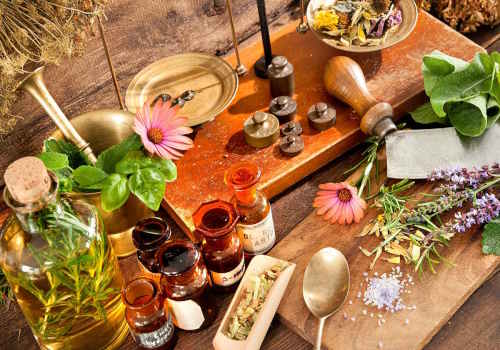
Herbal remedies are plants used like a medicine. People use herbal remedies to help prevent or cure disease. They use them to get relief from symptoms, boost energy, relax, or lose weight.
How can you know what you are getting and if it is useful? This guide can help you choose and use herbals safely.
Many medicinal plants are easy to grow in Colorado and have incredible healing properties. Horticulturist Blake Burger and horticulture intern Kenna Castleberry pick their top 10 to grow at home.
Have u ever found your grandma running after a doctor or medical store for every now & then? We have so many wonderful natural remedies all around for any burns, cut, cold, fever, sneezes and more.
It is very important to have medicinal plants around the house cause you never know when you might need them.
So here is a list of plants that have the highest medicinal value compared to the other million species around the world worth planting around the house.
1. Tulsi
There are four types of tulsi mentioned in ayurvedic texts ie Rama, Krishna, Vana & Kapoor Tulsi.
For over the centuries Tulsi (the queen of herbs) has been known for its remarkable healing properties.
- Tulsi is taken as herbal tea.
- The oil extracted from the Karpoora Tulsi is mostly used in the herbal toiletry. Its oil is also used against insects and bacteria.
- The Rama Tulsi is an effective remedy for Severe acute Respiratory Syndrome. Juice of its leaves gives relief in cold, fever, bronchitis and cough.
- Tulsi oil is also used as an ear drop.
- Tulsi helps in curing malaria.
- It is very effective against indigestion, headache, hysteria, insomnia, and cholera.
- The fresh leaves of Tulsi are taken by millions of people every day.
- Many people wear Tulsi beads, which is said to have certain physical and medicinal properties.
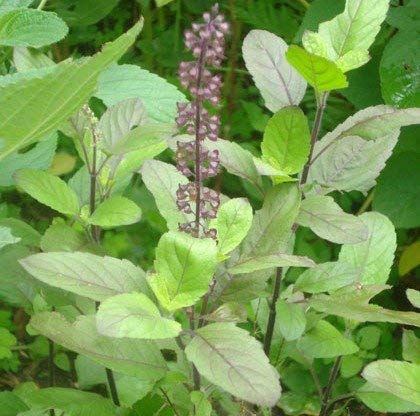 2. Aloe Vera
2. Aloe Vera
The aloe vera grows only under the sun with well-drained dry or moist soil. Although the plant tastes like a turd, it’s still edible. The sap from aloe vera is extremely useful to speed up the healing & reducing the risk of infections for :
- wounds
- cuts
- burns
- reducing inflammation
Apart from its external use on the skin, aloe vera is also taken internally in the treatment of :
- ulcerative colitis (drinking aloe vera juice)
- chronic constipation
- poor appetite
- digestive problems
 3. Gotu Kola
3. Gotu Kola
The gotu kola acts on various phases of connective tissue development and stimulates healing of :

- ulcers
- skin injuries
- decreasing capillary fragility
- stimulation of the lipids and protein necessary for healthy skin
- Leaves are thought to maintain youthfulness.
- Crushed leaves are poulticed to treat open sores.
The gotu kola can also be used to :
- treat leprosy
- revitalize the brain and nervous system
- increase attention span and concentration
- treat venous insufficiency
 4. Calendula
4. Calendula
It grows in almost any type of soil condition. It has no problem with nutritionally poor, very acidic or very alkaline soils, just as long as it’s moist. Well known as a remedy for skin problems, the deep-orange flowered pot marigold variety is applied externally to :
- bites
- stings
- sprains
- wounds
- sore eyes
- varicose veins
- Internally it is used to treat fevers and chronic infections.
- The tea of the petals tones up circulation and, taken regularly, eases varicose veins.
- Applying the crushed stems of the pot marigold to corns and warts will soon have them easily removable.
 5. Basil
5. Basil
You must have used basil lot many times in food but have you ever tried it to heal flatulence? It has the power to treat:
- Cuts
- Lack of appetite
- Stomach gas
- scrapes
 6. Thyme
6. Thyme
It is mostly known for its strong antiseptic nature. It is wonderful when it comes to the treatment of:
- Congestion
- Stomach gas
- Coughs
 7. Rosemary
7. Rosemary
Rosemary is the great reviver. This perennial woody herb stimulates energy and optimism and sharpens memory and concentration by bringing more oxygen to your brain, according to UMMC. It’s a wonderfully stimulating alternative to caffeine when you need that second wind!
A row of these long-lived and drought-tolerant plants makes a beautiful, bee-friendly, evergreen hedge. You may only need one plant in your garden, as a little bit goes a long way.
 8. Lavender
8. Lavender
Long recognized for its sweet perfume, lavender also boasts medical benefits as a nervine and mild antidepressant. UMMC suggests adding it to your bath to alleviate stress, tension, and insomnia. It’s also used in creams to treat sunburns and acne.
Woody lavender plants prefer hot, sunny, and dry environments. The fresh flowers are tasty in small doses when added to salads, honey, butter, lemonade, and even shortbread cookies. If you’re crafty, try sewing up an herbal heating pad or eye pillow with the fragrant dried flowers.
 9. German Chamomile
9. German Chamomile
Delicate, apple-scented chamomile demonstrates that mildness does not mean ineffectiveness. Primarily grown for its small, yellow-bellied flowers, NCCAM reports that chamomile is one of the best children’s herbs for treating colic, nervous stress, infections, and stomach disorders.
 10. Fenugreek, Methi
10. Fenugreek, Methi
Fenugreek seeds are nourishing and taken to :

- encourage weight gain (take note, anorexics)
- inhibit cancer of the liver
- lower blood cholesterol levels
- treat inflammation and ulcers of the stomach and intestines
- drain off sweat ducts
- for body building
- for late onset diabetes
- poor digestion
- insufficient lactation
- painful menstruation
- labor pains
- freshen bad breath
- restore a dull sense of taste
 11. Sage
11. Sage
Salvia, the Latin name for sage, means ‘to heal’. Internally, the sage is used for :
- indigestion
- flatulence
- liver complaints
- excessive lactation
- excessive perspiration
- excessive salivation
- anxiety
- depression
- female sterility
- menopausal problems
On the other hand, it is used externally for :
- insect bites
- skin infections
- throat infections
- mouth infections
- gum infections
- skin infections
- vaginal discharge
 12. Peppermint
12. Peppermint
Peppermint is sometimes regarded as ‘the world’s oldest medicine’, with archaeological evidence placing its use at least as far back as ten thousand years ago. Pepeprmint are naturally high in manganese, vitamin A and vitamin C. Crushed leaves rubbed on the skin help soothe and relax the muscles. Infused peppermint leaves are used to :
- reduce irritable bower syndrome
- against upset stomachs
- inhibit bacterial growth
- treat fevers
- flatulence
- spastic colon
 13. Lemon Balm
13. Lemon Balm
The reason the plant is called lemon balm is because of the lemon minty scent of the leaves. The flowers, which appear during the summer, are full of nectar. The crushed leaves, when rubbed on the skin, are used as :
- mosquito repellent
- herpes
- sores
- gout
- insect bites
Infusion of the leaves with water are known to treat :
- colds
- fevers
- indigestion due to nervous tension
- digestive upsets in children
- hyperthyroidism
- depression
- mild insomnia
- headaches

- Medicinal Garden
- With your seeds kit, you’ll also receive a FREE Medicinal Guide that shows you how to turn these 10 plants into tinctures, ointments, salves, poultices, decoctions, infusions, essential oils —all in minute detail so you can follow our guide even if you’ve never made an herbal medicine in your life.
14. Globe Artichoke
A bitter tasting plant that requires a lot of sun, the cardoon has become important as a medicinal herb in recent years following the discovery of cynarin. The cardoon leaves, best harvested before flowering, helps to :
- improve liver and gall bladder function
- stimulate the secretion of digestive juices
- lower blood cholesterol levels
- treat chronic liver and gall bladder diseases
- jaundice
- hepatitis
- asteriosclerosis
- early stages of late-onset diabetes
 15. Ashwangandha
15. Ashwangandha

Ashwagandhais best known for stress Reduction, Neural Protection, and a Lot More from an Ancient Herb
The benefits of ashwagandha are many; in addition to promoting fertility, aiding in wound care, and boosting the immune system, some other benefits are:
- Diuretic, Sleep aid
- Galactogogue
- Anti-epileptic
- Anti-tumor, Pain relief
- Eye health
- Heart tonic
- Lowers cholesterol & Regulates blood sugar
- Reduces depression and anxiety, Combats stress
- Fights cognitive decline due to brain cell degeneration
 16. Lemon Grass
16. Lemon Grass
Lemongrass has been reported to have innumerable therapeutic and other health benefits.
- alleviate certain respiratory conditions including laryngitis and sore throats
- anti-pyretic property which reduces high fevers.
- useful for all types of pain including abdominal pain, headaches, joint pains, muscle pains, digestive tract spasms, muscle cramps, stomachache and others
- lemongrass inhibits bacteria and yeast growth.
- beneficial for nervous and stress-related conditions.
 17. Bryophyllum, Panfuti
17. Bryophyllum, Panfuti
Bryophyllum calycinum, Bryophyllum pinnatum, also known as the Air Plant, Life Plant, Miracle Leaf, Goethe Plant and the Katakataka (Filipino)) is a succulent plant native to Madagascar.
- The leaf or its juice is taken for diabetes.
- Leaf paste application stops bleeding and heals wounds.
- The burnt leaf (mashi) made in to paste with coconut oil cures burn.
- To prevent septic to cuts from sharp instruments, 15 leaves with four pepper corns roasted, powdered and mixed in cow ghee is applied.
- Leaf paste boiled in oil cures sciatica and rhematic pains.
- One leaf eaten raw with one pepper corn first thing every morning for 3 to 7 days cures urinary stones.
- The leaves can be used raw for making chutneys or tamblis.
 18. Rui
18. Rui
RUVA, Purple ( Ekke, Rui,arka ) Calotropis gigantea
- The leaves and flowers of both the varieties are used for pooja of Shiva, Hanuman and Devi.
- Leaves of both varieties are used for fomentation to paining joints.
- Fomentation of leaves after application of castor oil relieves stomach pain of infants.
 19. Costus
19. Costus
Costus igneus, commonly known as insulin plant in India, belongs to the family Costaceae. Consumption of the leaves are believed to lower blood glucose levels, and diabetics who consumed the leaves of this plant did report a fall in their blood glucose levels.
The fresh leaves of this plant is chewed two times daily for 1 week after 1 week, 1 leaf should be chewed twice a day this dosage should be continued for 1 month. It is said that this treatment is effective in bringing blood sugar levels under control in diabetes patients.
 20. Khus
20. Khus
It has anti-inflammatory and antiseptic effects that provide relief from inflammations in circulatory system and nervous system. Khus khus is used to create a tonic bath, which is the reason why it is often included in high quality soaps.
It is a boon for individuals suffering from rheumatism, arthritis, gout, muscular aches, dryness and cracking of skin etc.
The oil obtained from khus khus has sedative effect and aids in the treatment of emotional outbursts, such as anger, anxiety, epileptic and hysteric attacks, restlessness, nervousness, etc.
 21. Vitex Negundo
21. Vitex Negundo
Commonly known as the five-leaved chaste tree, is a large aromatic shrub with quadrangular, densely whitish, tomentose branchlets.
Key therapeutic benefits:
- Because of its anti-inflammatory, antibacterial and antifungal properties, the plant is useful in treating sores and skin infections.
- Five-Leaved Chaste Tree relieves muscle aches and joint pains.
- The herb is effective in treating vaginal discharge.
 22. Sagargota, Bonduc nut
22. Sagargota, Bonduc nut
Sagargota, Bonduc nut, Fever nut, physic nut is used as anti diabetic & anti-malarial drug
Medicinal Uses :
- Root : In dysentery and diabetes
- Leaves : Emmenagogue
- Seed : Abortifacient used as anti-malarial drug and also tonic
 23. Stevia
23. Stevia
With its steviol glycoside extracts having up to 300 times the sweetness of sugar,stevia has garnered attention with the rise in demand for low-carbohydrate, low-sugar food alternatives.
Because stevia has a negligible effect on blood glucose, it is attractive as a natural sweetener to people on carbohydrate-controlled diets.
 24. Marsh Mallow
24. Marsh Mallow
The plant of which marshmallows were once made of. The root is taken internally to treat :

- inflammations and irritations of the urinary and respiratory mucus membranes
- counter excess stomach acid
- peptic ulceration
- gastritis
Externally, the root is applied to :
- bruises, sprains
- aching muscles
- insect bites
- skin inflammations, splinters
- The leaves are very edible, unlike the aloe vera. They can be added to salads, boiled, or fried. It is known to help out in the area of cystitis and frequent urination.
 25. Great Burdock
25. Great Burdock
It requires moist soil and can grow shadeless. The great burdock is the pretty famous in the area of detoxification in both Chinese and Western herbal medicine. The root is is used to treat ‘toxic overload’ that result in throat infections and skin diseases like :
- boils, rashes, burns, bruises
- herpes, eczema, acne
- impetigo, ringworm, bites
- The leaves and seeds can be crushed to poultice it to bruises, burns, ulcers and sores
 26. Camomile
26. Camomile
With a sweet, crisp, fruity and herbaceous fragrance, has long been used medicinally as a remedy for problems regarding the digestive system.
It has a soothing and calming effect in the area of aromatherapy, used to end stress and aid in sleep.
The entire herb is used to treat common aches like toothache, earache, shoulder pain and neuralgia.
 27. Chinese Yum
27. Chinese Yum
A type of yam that can be eaten raw, the chinese yam can be easily grown, succeeding in fertile, well drained soil in a sunny position. It is sweet and soothing to the stomach, spleen and has a tonic effect on the lungs and kidneys. It is used internally to treat :
- tiredness, weight loss, loss of appetite, poor digestion, chronic diarrhea
- asthma, dry coughs, uncontrollable urination, diabetes, emotional instability
Externally, it is applied to ulcers, boils, abscesses
- The leaf, on the other hand, is used to treat snakebites and scorpion stings.
 28. Echinacea
28. Echinacea
One of the world’s most important medicinal herbs, the echinacea has the capacity to raise the body’s resistance to bacterial and viral infections by stimulating the immune system. It also has antibiotic properties that helps relieve allergies. Basically, the roots are beneficial in the treatment of sores, wounds and burns.
It was once used by the Native Americans as an application for insect bites, stings and snakebites. The echinacea grows on any well drained soil, as long as it gets sunlight.
 29. Siberian Ginseng
29. Siberian Ginseng
The siberian ginseng has a wide range of health benefits, mostly as a powerful tonic herb that maintains good health. Its medicinal properties are used for :
- menopausal problems, geriatric debility, physical and mental stress
- treat bone marrow suppression caused by chemotherapy or radiation
- hypercholesterolemia and neurasthenia with headache
- insomnia, poor appetite, increasing endurance, memory improvement
- anti-inflammatory purposes
- immunogenic purposes
- chemoprotective purposes
- radiological protection
 30. The Great Yellow Gentian
30. The Great Yellow Gentian
The great yellow gentian root is a bitter herb used to treat digestive disorders and states of exhaustion from chronic diseases. It stimulates the liver, gal bladder, and digestive system, strengthening the overall human body. Internally, it is taken to treat :
- liver complaints
- indigestion
- gastric infections
- anorexia
 31. Sea Buckthorn
31. Sea Buckthorn
The sea-buckthorn has been used throughout the centuries in China to relieve cough, aid digestion, invigorate blood circulation and alleviate pain. The branches and leaves are used in Mongolia to treat gastrointestinal distress in humans and animals.
The bark and leaves are used for treating diarrhea, gastrointestinal, dermatological disorders and topical compressions for rheumatoid arthritis. Even the flowers are used as skin softeners.
The berries, on the other hand, are used together with other medications for pulmonary, gastrointestinal, cardiac, blood and metabolic disorders. Fresh sea buckthorn berry juice is known to be taken in the event of colds, fever, exhaustion, stomach ulcers, cancer, metabolic disorders, liver diseases, inflammation, peptic ulcer, gastritis, eczema, canker sores, general ulcerative disorders, keratitis, trachoma
 32. Tea Tree
32. Tea Tree
Even the aborigines have been using the tea tree leaves for medicinal purposes, like chewing on young leaves to relieve headaches. The paperbark itself is extremely useful to them as it serves to line coolamons when used as cradles, as a bandage, like a sleeping mat, as material for building humpies, as an aluminum foil, as a disposable raincoat and for tamping holes in canoes.
The leaves and twigs, eventually made into tea tree oil, is anti-fungal, antibacterial, antiseptic and deserves a place in every household medicine box. Tea tree oil can be used to treat: cystitis, glandular fever, chronic fatigue syndrome, thrush, vaginal infections, acne, athlete’s foot, verrucae, warts, insect bites, cold sores, nits, minor burns
 These easy-to-grow herbs bring health benefits to your garden as well as your family. Many attract beneficial insects, including bees, and help repel harmful pests from more sensitive plants nearby.
These easy-to-grow herbs bring health benefits to your garden as well as your family. Many attract beneficial insects, including bees, and help repel harmful pests from more sensitive plants nearby.
Be sure to locate plants with their preferred conditions for light, water, and temperature in mind.
The Home Doctor
Do you know about the gift of nature to save the life of people from various health problems and make them feel secure by curing significant issues? How to live healthy in this world without having chronic diseases or illness or any other health issues which may hurt you physically and mentally? Due to dense population, people are trying to demolish the forest, garden areas to create shelter, so they forced to destroy the nature’s gift such as natural ingredients, secret medicinal herbs and more which are grown in wild forest, mountains and other places. When you read this review entirely, sure you will get chance to know about secrets medicinal ingredients, herbs and more used by our ancestor to get back the lost health without losing your life. Claude Davis was highlighted all the stuff in the form of the e-bookThe Home Doctor filled with a list of natural ingredients and remedies that you can quickly grow in the backyard or at free space to include it in your routine diet or external usage to get well soon.

Books can be your best pre-collapse investment.
Carnivore’s Bible (is a wellknown meat processor providing custom meat processing services locally andacross the state of Montana and more. Whether your needs are for domestic meator wild game meat processing)
The Lost Book of Remedies PDF ( contains a series of medicinal andherbal recipes to make home made remedies from medicinal plants and herbs.Chromic diseases and maladies can be overcome by taking the remediesoutlined in this book. The writer claims that his grandfather was taughtherbalism and healing whilst in active service during world war twoand that he has treated many soldiers with his home made cures. )
Easy Cellar(Info about building and managing your root cellar, plus printable plans. The book on building and using root cellars – The Complete Root Cellar Book.)
The Lost Ways (Learn the long forgotten secrets that helped our forefathers survive famines,wars,economic crisis and anything else life threw at them)
LOST WAYS 2 ( Wordof the day: Prepare! And do it the old fashion way, like our fore-fathers did it and succeed longbefore us,because what lies ahead of us will require all the help we can get. Watch this video and learn the 3 skills that ensured our ancestors survival in hard times offamine and war.)
A Guide to Herbal Remedies - Natural Remedies For Everyday Illnesses - PrepperFortress
Last edited by Airbornesapper07; 06-23-2024 at 04:51 AM.
If you're gonna fight, fight like you're the third monkey on the ramp to Noah's Ark... and brother its starting to rain. Join our efforts to Secure America's Borders and End Illegal Immigration by Joining ALIPAC's E-Mail Alerts network (CLICK HERE)
-
07-10-2023, 01:38 PM #7798
Let the Native American's and Amish farm our land.
Confiscate it from corrupt Bill Gates and China and GIVE it to them under the condition they farm it and send it to Farmer's Markets across America. They should be farming our Federal and State Land.
Put corporations out of business poisoning us with their chemicals and changing children's bodies, making us sick, full of cancer, with their poison.
Evil Bill Gates making billions off of his clot shots and vaccines.ILLEGAL ALIENS HAVE "BROKEN" OUR IMMIGRATION SYSTEM
DO NOT REWARD THEM - DEPORT THEM ALL
-
07-10-2023, 01:39 PM #7799
Migraine Treatment Herbal Home Remedies from Around the World
Amy S. June 19, 2023 No Commentson Migraine Treatment Herbal Home Remedies from Around the World
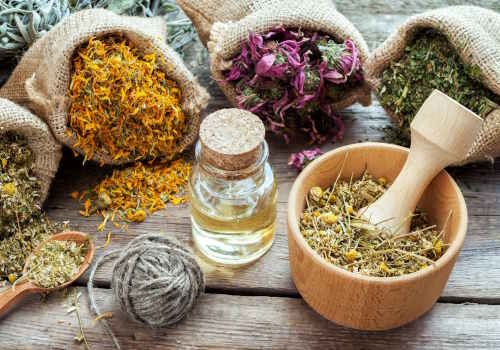
Herbal remedies for migraines
If you’re one of the millions of Americans who experience migraines, you know they’re much more than just a headache. The intense throbbing, pulsing, and excruciating pain that accompany a migraine can be debilitating. In fact, more than 90 percent of people who get migraines can’t work or function normally during an episode, the Migraine Research Foundation reports.
Most people who experience migraines opt for medication. But many are turning to natural therapies such as relaxation techniques and herbal remedies.
Years before the introduction of modern medicine, cultures worldwide developed herbal remedies for headaches and other common migraine symptoms. Many of these herbal traditions have survived the passage of time. Although most herbal migraine remedies haven’t been thoroughly scientifically tested for their effectiveness, many are rapidly gaining the support of the modern medical community.
Always use caution when considering herbal treatments for migraines. Discuss your decision with a healthcare professional before beginning or stopping any medical or herbal treatment. Many herbs interfere with other medications.
What is migraine?
Migraine treatment with medicinal plants: Migraine is a problem or disease with nervous source, which involves and struggles many people around the world.
This disease usually occurs in form of frequent headaches in a part of head along with signs that bother all aspects of a person life.
Migraine signs include:
Consciousness disorders
Speaking problems
Headache
Vertigo
Unclear vision
Nausea and vomiting
Sensitivity to light and sound
Dipression
Neck ache
Eye pain
Fast heart beat
Petulancy
Which factors cause migraine?
Lack of vitamin B, riboflavin and Q10 co-enzyme
Genetics
Migraine treatment with medicinal plants
Medicinal plants have noticeable and important influence without any hazardous side effects in migraine pain relief.
This paper briefly discuss the most important medicinal plants for migraine treat.
Feverfew (Tanacetum parthenium)
First used in ancient Greece in as early as the fifth century B.C., feverfew (or “featherfew”) has been used to treat a variety of ailments. These include fever, swelling, and inflammation. People commonly took the herb to relieve aches and pains such as headaches in the first century.
The plant is native to the Balkan Mountains but can now be found nearly worldwide. Eastern European cultures traditionally used feverfew for headaches, insect bites, and other pain. More modern uses have extended to the treatment of:
- migraines
- dizziness
- inflammation
- breathing problems
Feverfew is usually prepared by drying the leaves, flowers, and stems. This combination is also used to make supplements and extracts. Some cultures eat the leaves raw.
A 2011 review suggests that feverfew is an effective treatment for migraines, fever, the common cold, and arthritis. However, a CochraneTrusted Source review of five large clinical trials showed little to no benefit for the majority of people who experience migraines.
Feverfew may cause minor side effects such as bloating, canker sores, and nausea. You may also experience moderate side effects when discontinuing use. These side effects can include difficulty sleeping, increased headaches, and joint pain.
Pregnant women, people taking blood thinning medications, and people with allergies to the daisy family should avoid the use of feverfew.

Butterbur (Petasites hybridus)
Butterbur is found in wet, marshy areas of Europe, Asia, and North America. People once used the leaves of the plant to wrap and preserve butter during warm weather, which is how butterbur got its name. It’s been used throughout history for a variety of purposes. The Greek physician Dioscurides originally used the plant as a skin ulcer remedy. Since then, it’s been used to treat:
- headaches
- asthma
- allergies
- cough
- fever
- gastrointestinal problems
- general pain
Most butterbur herbal remedies use its purified root extract, Petasites, in pill form to treat headaches and migraines. A 2012 study published in NeurologyTrusted Source supports conclusions from older studies that Petasites is effective for migraine prevention when taken as 50- to 75-milligram doses twice daily.
If you live in Europe, Butterbur might be hard for you to obtain — the U.K. and Germany have both banned butterbur from being sold because of safety concerns with the leading manufacturers.
Peppermint (Mentha x balsamea)
 A cross of spearmint and water mint, peppermint grows throughout North America, Europe, and Asia. Peppermint leaves and their essential oils are used for medicinal and culinary purposes. In addition to a headache treatment, it’s also used to relieve:
A cross of spearmint and water mint, peppermint grows throughout North America, Europe, and Asia. Peppermint leaves and their essential oils are used for medicinal and culinary purposes. In addition to a headache treatment, it’s also used to relieve:
- spasms
- toothaches
- gastrointestinal problems
- nausea
Peppermint oil and its active ingredient, menthol, is available in liquid capsule form. Tea versions are also available for easy brewing.
A 2010 study published in the International Journal of Clinical PracticeTrusted Source found that menthol was effective at stopping migraine pain and easing nausea when applied to the forehead and temples in a 10 percent solution.
Research is limited on its clinical effectiveness, but topical peppermint oil may be a good herbal option for the relief of migraine pain. Peppermint oil is one of the easiest herbal remedies to try because of its prevalence in health food stores and pharmacies.
Willow (Salix spp.)
Willow bark extract (WBE) was used in the development of aspirin, a well-known over-the-counter pain reliever, fever reducer, and anti-inflammatory drug. WBE contains an anti-inflammatory ingredient called salicin. A 2012 studyTrusted Source suggests WBE is also an effective antioxidant.
Willow is a tree found in Europe, Asia, and North America. It’s been used since the time of Hippocrates (400 B.C.), when people would chew the bark for its anti-inflammatory and fever-relieving effects. Willow was later used in China and Europe for headaches, osteoarthritis, tendonitis, and lower back pain.
Willow bark can be found in capsule form and as a chewable bark at most health food stores.
Ginger (Zingiber officinale)
 Ginger is a tropical Asian plant. It’s been used in herbal medicines in China for over 2,000 years. It’s also been popular in Indian and Arabic medicines since ancient times. Ginger has traditionally been used as a remedy for:
Ginger is a tropical Asian plant. It’s been used in herbal medicines in China for over 2,000 years. It’s also been popular in Indian and Arabic medicines since ancient times. Ginger has traditionally been used as a remedy for:
- headaches
- stomach pain
- nausea
- arthritis
- cold and flu symptoms
- neurological problems
Ginger has been well-documented as anti-inflammatory, antiviral, antifungal, and antibacterial. In addition, a 2014 study published in the Phytotherapy ResearchTrusted Source showed that ginger powder’s benefits were comparable to sumatriptan’s, a common prescription migraine drug, but with fewer side effects.
Most people can tolerate fresh or dried ginger root, supplements, or extract. Be careful not to combine ginger supplements with blood thinners because of potential drug interactions.
Ginger capsules and ginger tea are both relatively easy to obtain in almost any grocery store or pharmacy. You can also try drinking ginger water.

Caffeine
Caffeinated teas became common in China during the Ming Dynasty. They exploded in popularity in Europe during the 18th and 19th centuries. Green tea was used in combination with other herbs for migraine pain in traditional Chinese medicine. Coffee initially gained recognition in Arabia. Yerba mate, a less widely known caffeinated tea, originated in South America.
People in many cultures primarily consumed caffeine to help treat:
- headaches
- high blood pressure
- stomach problems
- sexually transmitted diseases
- cancer
- circulatory problems
- inflammation
- skin damage
- kidney disease
Caffeine is also found in many over-the-counter pain relievers today.
Although caffeine is frequently studied in combination with other pain relievers, it’s considered a useful and safe additive in pills for many people who experience migraines. A 2012 studyTrusted Source found that a combination of 1,000 milligrams (mg) of acetaminophen and 130 mg of caffeine is particularly helpful. However, caffeine withdrawal and caffeine intake can also be triggers for headaches and migraines.
Valerian (Valeriana officinalis)
Valerian is native to Europe and Asia. It’s now also commonly found in North America. Use of valerian traces back to ancient Greece and Rome from the time of Hippocrates. It was recognized as a remedy for insomnia a few centuries later. Valerian was known as “all-heal” in the 1500s, as it was used to treat a multitude of ailments. These included:
- insomnia
- headaches
- heart palpitations
- tremors
- anxiety
It’s sometimes used in the modern treatment of headaches, but valerian hasn’t been researched enough to determine its usefulness in the treatment of migraine pain.
Valerian is usually taken as a supplement, tea, or tincture made from the dried roots. Liquid extract is also available in capsule form. Valerian root capsules are widely sold in the United States.
Coriander seed (Coriandrum sativum)
For over 7,000 years, people across cultures have used coriander seed’s healing and seasoning properties. Coriander was lauded for its ability to treat ailments that ranged from allergies to diabetes to migraines. Traditional Ayurvedic medicine used coriander to relieve sinus pressure and headaches by pouring hot water over the fresh seeds and inhaling the steam.
Research on the seed’s medicinal effects is generally focused on its potential to treat arthritis and diabetes. More studies need to be conducted to determine if it’s useful as a remedy for migraine pain. However, coriander seed’s anti-inflammatory potential may prove beneficial for some people with migraines.
Coriander seeds can be chewed and used in food or teas. Oral extracts are also available.
Dong quai (Angelica sinensis)
Hailing from the same family as carrots, parsley, and celery, dong quai root has been used as a spice, tonic, and medicinal cream for more than 1,000 years, especially in Japanese, Chinese, and Korean practices. Modern uses often mix it with other herbs to treat:
- headaches
- fatigue
- inflammation
- nerve pain
Despite its history, the root hasn’t been studied enough to recommend it as an effective treatment for migraine pain.
Lavender oil (Lavandula angustifolia)
 Known for its sweet smell, lavender oil (made from the flowers of the lavender plant) is highly fragrant and has long been used to perfume hygiene products. Lavender is indigenous to the mountainous regions surrounding the Mediterranean. It’s now widely grown throughout Europe, Australia, and North America.
Known for its sweet smell, lavender oil (made from the flowers of the lavender plant) is highly fragrant and has long been used to perfume hygiene products. Lavender is indigenous to the mountainous regions surrounding the Mediterranean. It’s now widely grown throughout Europe, Australia, and North America.
Lavender oil was used in ancient Egypt during the mummification process. Because of its antimicrobial properties and clean scent, it was later added to baths in Rome, Greece, and Persia. The aromatic flowers and their oil were used to treat everything from headaches and insomnia to mental health complaints such as stress and fatigue. Many of these historical uses remain popular today.
A 2012 studyTrusted Source suggests that inhaling lavender oil during a migraine may help relieve symptoms quickly. To use lavender oil, breathe in the oil or apply a diluted solution to the temples. If you don’t dilute it properly, the oil may irritate the skin at the application site. Lavender oil can be toxic when taken orally at certain doses.
Rosemary (Rosmarinus officinalis)
 Rosemary is native to the Mediterranean region. Medicinal uses have included the treatment of:
Rosemary is native to the Mediterranean region. Medicinal uses have included the treatment of:
- muscle and joint pain
- memory problems
- concentration difficulties
- nervous disorders
- circulatory problems
- liver ailments
- migraines
Rosemary oil can be diluted and applied topically or inhaled for aromatherapeutic purposes. The plant’s leaves can be dried and ground for use in capsules. It can also be used in teas, tinctures, and liquid extracts. Rosemary is believed to have antimicrobial, antispasmodic, and antioxidant effects. Still, its ability to reduce migraine pain hasn’t been well studied.
Linden, lime tree (Tilia spp.)
Linden, also known as lime tree or Tilia, is a tree whose blossoms have been used in medicinal teas in European and Native American cultures. The plant has been used to calm nerves and ease anxiety, tension, and inflammatory problems, among other issues. The blossoms can also be used in tinctures, liquid extracts, and capsules.
Linden has been shown to have sweat-inducing and sedative properties. It’s been used to relieve tension and sinus headaches, calm the mind, and induce sleep. The flowers have also been used to relieve nasal congestion and lower high blood pressure.
This tea is sometimes used in modern alternative medicine for the treatment of headaches and migraines. There currently isn’t enough research about the effect of linden tea on migraines to recommend it as an effective natural remedy.

Raw potato cuttings
The potato has been used in European folk medicine for over 200 years. Country folk medicine has anecdotally supported the use of thick slices of raw potato in calming migraine pain. Traditionally, the slices are cloaked in a thin cloth and wrapped around the head or rubbed directly on the temples to ease tension and pain. There is no current scientific research suggesting that raw potato cuttings can effectively treat migraines when applied topically.
Horseradish (Armoracia rusticana)
 Native to Europe, horseradish has been used in medicinal folk remedies as an oil extract or in dried or fresh root form. It has historically been used to treat:
Native to Europe, horseradish has been used in medicinal folk remedies as an oil extract or in dried or fresh root form. It has historically been used to treat:
- bladder infections
- kidney disease
- respiratory problems
- joint pain
- arthritis
- muscle strains
Its ability to narrow blood vessels may aid in treating migraines, but no clinical trials support the use of horseradish for migraines.
Honeysuckle (Lonicera japonica)
Native to Asia, the Japanese honeysuckle started taking root in North America in the 1800s. It’s been used in traditional Chinese medicine to treat:
- wounds
- fever
- colds and viruses
- inflammation
- sores
- infections
Along with honeysuckle’s anticancer and antimicrobial powers, research has also identified anti-inflammatory properties in the plant’s leaves, stems, and flowers that can provide pain relief similar to that of aspirin. It may also be effective against migraine pain.
The Home Doctor
Do you know about the gift of nature to save the life of people from various health problems and make them feel secure by curing significant issues? How to live healthy in this world without having chronic diseases or illness or any other health issues which may hurt you physically and mentally? Due to dense population, people are trying to demolish the forest, garden areas to create shelter, so they forced to destroy the nature’s gift such as natural ingredients, secret medicinal herbs and more which are grown in wild forest, mountains and other places. When you read this review entirely, sure you will get chance to know about secrets medicinal ingredients, herbs and more used by our ancestor to get back the lost health without losing your life. Claude Davis was highlighted all the stuff in the form of the e-bookThe Home Doctor filled with a list of natural ingredients and remedies that you can quickly grow in the backyard or at free space to include it in your routine diet or external usage to get well soon.
Mullein (Verbascum)
Since ancient times, people in Europe and Asia have been using mullein for medicinal purposes, treating inflammatory conditions, spasms, diarrhea, and migraines. The leaves and flowers can be used for extracts, capsules, poultices, and dried preparations. Tinctures of the plant are used in modern homeopathic therapies for migraine treatment. ResearchTrusted Source has shown that mullein has diuretic properties.
Yarrow (Achillea millefolium)
Believed to be named after Achilles, the Greek mythical hero, yarrow has historically been used to heal wounds and slow blood loss. Other folk remedies encourage the use of yarrow to treat inflammatory conditions, muscle spasms, and anxiety or insomnia. More recent folk remedies have used yarrow to relieve colds, flus, coughs, and diarrhea.
Yarrow has also been shown to have pain-relieving, anti-anxiety, and antimicrobial properties. Although more research is needed, the plant contains anti-inflammatory properties that may provide relief to people who experience migraines. Yarrow can be used in a variety of forms, including capsules and tinctures.
Teaberry (Gaultheria procumbens)
Teaberry, popularly known as wintergreen, is native to eastern North America. This edible plant, made famous by Teaberry gum, has long held a place in folk medicine for its anti-inflammatory properties. It can be used to make teas, tinctures, and oil extracts.
Teaberry also has been used historically as an astringent and as a stimulant to fight fatigue. Most important for people who experience migraines is teaberry’s potential to treat neuralgias and headaches as well as stomach pain and vomiting.
You can brew teaberry in hot water for 3 to 4 minutes and drink the mixture to experience its healing effects.
Common hops (Humulus lupulus)
Hops are native to Europe and western Asia and can now be found throughout North America. Once used as a food in ancient Roman culture, this flavorful plant also has significant medicinal properties. Hops have historically been used to treat:
- sleep problems
- inflammation
- infections
- neuralgia (pain from nerve damage)
- fever
- cramps
- spasms
- anxiety
Modern medicine acknowledges the sedative effect of hops, but hasn’t thoroughly studied it for its impact on migraine pain.
Betony (Stachys officinalis)
This perennial herb can be found throughout Europe and Asia. It’s been used as a medicinal plant since classical times. The plant has traditionally been used to relieve headaches and facial swelling and pain. The leaves can be used as a juice, poultice, or ointment.
The mildly sedative properties of the plant are used to treat headache and migraine pain, menstrual cramps, stress, and tension. It may help alleviate sinus headaches and congestion when used in combination with lime flowers and comfrey.
However, there have been no human clinical trials performed to demonstrate the plant’s effectiveness against migraine pain. It’s not always easy to find betony in health food stores, so you may have to grow your own or buy it online.
Betony can have a tonic effect on the body. It’s important to avoid the herb if you’re pregnant.
Evodia (Evodia rutaecarpa)
This deciduous tree is a native to China and has been used in Chinese medicine since the first century A.D. Evodia has traditionally been used to treat abdominal pain, headaches, diarrhea, and vomiting. The fruits of the tree may also reduce blood pressure. The anti-inflammatory and pain-reducing properties of the fruit may help ease migraine pain.
Lemon Balm ; a strong relaxtion
A herbaceous perennial plant, hairless, broad and opposite leaves, flower cup white or blue-purple and hairy in the outer surface.
It is native to Mediteranian regions and in Iran is cultivated in Mazandaran, West and East Azarbaijan, yazd and etc provinces.
Lemon Balm contain tannin, geraniol, linalol, citronal, citral, sugar and etc. Which is known as a strong relaxtion.
The scientific name is Dracocephalum moldavica
Incredible properties of lemon Balm
- Sever migraine remedy
- Headache treat
- Stress relaxation
- Nervous tire treat
- Menstruation disorders regulation
- Natural relax
- Heart, stomach and intestine reinforce
Application method for migraine:
Add a portion of leaves in 0.5 L boiling water and drink with honey after purifying.
Maleki commercial is the biggest exporter of lemon Balm in Iran and Asia. For main order, you may call our advisors.

Echium Amoenum (Persian Borage)
Migraine treatment with medicinal plants:A perennial plant, 20-80 cm height, soft and thin hairs, purple and violet flowers, achene fruits erect with hard and accumulate surface.
It is native to Iran.It contains mucilage, sodium, potassium, flavonoids and linoleic fatty acid.
Echium Amoenum (Persian borage) therapeutically and medicinal properties
- Useful for migraine headaches
- Relives headache
- Heart and liver reinforce
- Treats stress and depression
- Regulates menstruation disorders
- Good for pain relief and hysteria
- Borage tea treats cold
Application method for migraine:
Add a portion of flowers to boiling water and drink after purification.
Maleki commercial is the biggest exporter of Echium Amoenum (Persian borage) in Iran and Asia. For main order, you may call our advisors.
Lemon balm
A herbaceous plant, 30-120 cm height with soft trichomes, flower calyx approximately 7 mm, opposite and ovate leaves and white flowers.
Dried leaves are known as the medicinal organ of lemon balm.
The scientific name is Melissa offiinalis L. That is usually mistaken with lemon grass and both are introduced as one plant. But they are two individual species completely different.
Lemon balm therapeutically and medicinal properties
- Migraine pain relief
- Headache relief
- Stress treat
- Nervous pain relief
- Mental and physical tonic
- Heart and brain reinforce
- Menstruation regulation
- Sleep regulation
- Anti-spasm
- Anti-pain and anti-bacterial
- Anti-thyroid
- Uterus tonic
- Anti-fungi and anti-virus
- Rheumatism pain relief
Application method for migraine:
Add a portion of leaves to 0.5 L boiling water and drink after 20 minutes and purifying.
Drink this herbal tea after mill.
Verbena
A perennial plant, 60-80 cm height, opposite ovate leaves with round edges, pink to purple flowers.
The scientific name is Verbena officinalis L.
This plant contains monoterpenes, cafeic acid derivatives and flavonoids.
Whole dry plant is the medicinal part.
Verbena therapeutically and medicinal properties
- Migraine headache relief
- Moderate relax
- Nervous tonic
- Anti-depression
- Anti-rheumatism
- Cough and throat ache relief
- Insomnia remedy
- Asthma remedy
- Menstruation disorder regulation
- Sex appetite enhancer
- Milk enhancement in breast feeding mothers
Application method for migraine:
Add a portion of Verbena to boiling water and drink after purifying.
Valerian
A plant with relatively thick stems, full hairy, basal leaves 4-8 long and 3-8 cm wide, white to pink flowers.
The scientific name is Valeriana Jatamansii Johns.
It grows in Afghanistan, Pakistan and Kashmir.
Valerian do not grow in Iran and is imported to our country.
Dried roots are known as the medicinal organ.
Valerian therapeutically and medicinal properties
- Migraine pain relief
- Headache relief
- Anti-purgative
- Anti-hysteria
- Stomach tonic
- Hysteria remedy
- Fast heart beat treat
- Reduce menopause signs
- Sleep regulation and relaxation
- Nervous and act disorder treat
Application method for migraine:
Add 2 teaspoons of valerian root powder to 0.5 L boiling water and drink after 20 minutes and purifying.
Maximum daily does is 2 cups a day. For gaining more effective influences, it is better to use before night sleep.
Warnings and potential complications
Although many herbal remedies can be safe when used correctly, they may also have side effects like any prescription medication would. Some herbs can interact with medications, such as oral contraceptives or heart drugs. Herbs can be dangerous or even deadly when misused. Some have little research to back claims, verify toxicity levels, or identify potential side effects.
Types of migraines
Migraine without aura
This is the most common kind of migraine headache. It builds over several hours before the pain of your migraine peaks, usually lasting up to 72 hours. People who have these kinds of migraines tend to experience them a few times per year. If they occur more often than that, the condition may be diagnosed as chronic migraine.
Migraine with aura
Some people experience disturbances of the nervous system, called aura, during their migraines. Auras can include bright spots in the field of vision, tingling sensations, vision loss, hallucinated odors, and uncontrolled movements.
Retinal migraine
Retinal migraines involve vision loss in one eye. Unlike migraines with aura, the visual disturbances are usually contained to that eye.
Chronic migraine
Chronic migraine is defined as having migraines that occur on more than 15 days per month for 3 months or more. This frequency can be debilitating. Medical evaluation is required to obtain a treatment plan and to identify if something else is causing the migraines to occur so often.
Migraine triggers
Certain behaviors, emotions, hormones, and foods can trigger a migraine. Caffeine or chemical withdrawal can cause migraines, for example. Chocolate, food dyes and additives, preservatives, aspartame, and cured meats are the most common dietary triggers for migraines, according to the American Nutrition Association. Food allergies and sensitivities can also activate migraines as a symptom.
A high-stress, competitive lifestyle can sometimes lead to recurrent migraines. Emotional stress from chemicals released during emotional situations can provoke a migraine. Hormones are also a notorious migraine trigger. For women, the menstrual cycle is often connected to when their migraines occur. You may want to consider if there are migraine patterns or triggers that you can identify before you decide to try an herbal treatment.
Takeaway
In addition to herbal treatments, significant research shows that diet can play a major role in migraine frequency, duration, and intensity. Potential preventive measures and treatments for migraines include:
- eating a low-fat diet
- eliminating or limiting foods that show IgG antibody production
- improving gut flora content
- eating consistently to minimize low blood sugar
Just like medications, herbs can have significant side effects on the body. Some can interact with other medicines and be dangerous or even deadly when misused. Discuss all treatment options with your doctor before use.
Consider tracking your triggers, symptoms, pain intensity and duration, and other related factors in a migraine journal or migraine app. Whether you choose pharmaceutical treatments, natural remedies, or a combination, having a thorough record of your experiences will help you and your doctor narrow down the best treatment options.
It might also be helpful to talk to others about their own experiences with migraines. Our free app, Migraine Healthline, connects you with real people who experience migraines. Ask treatment-related questions and seek advice from others who get it.
- Medicinal Garden
- With your seeds kit, you’ll also receive a FREE Medicinal Guide that shows you how to turn these 10 plants into tinctures, ointments, salves, poultices, decoctions, infusions, essential oils —all in minute detail so you can follow our guide even if you’ve never made an herbal medicine in your life.

Books can be your best pre-collapse investment.
Carnivore’s Bible (is a wellknown meat processor providing custom meat processing services locally andacross the state of Montana and more. Whether your needs are for domestic meator wild game meat processing)
The Lost Book of Remedies PDF ( contains a series of medicinal andherbal recipes to make home made remedies from medicinal plants and herbs.Chromic diseases and maladies can be overcome by taking the remediesoutlined in this book. The writer claims that his grandfather was taughtherbalism and healing whilst in active service during world war twoand that he has treated many soldiers with his home made cures. )
Easy Cellar(Info about building and managing your root cellar, plus printable plans. The book on building and using root cellars – The Complete Root Cellar Book.)
The Lost Ways (Learn the long forgotten secrets that helped our forefathers survive famines,wars,economic crisis and anything else life threw at them)
LOST WAYS 2 ( Wordof the day: Prepare! And do it the old fashion way, like our fore-fathers did it and succeed longbefore us,because what lies ahead of us will require all the help we can get. Watch this video and learn the 3 skills that ensured our ancestors survival in hard times offamine and war.)
Migraine Treatment Herbal Home Remedies from Around the World - PrepperFortress
If you're gonna fight, fight like you're the third monkey on the ramp to Noah's Ark... and brother its starting to rain. Join our efforts to Secure America's Borders and End Illegal Immigration by Joining ALIPAC's E-Mail Alerts network (CLICK HERE)
-
07-10-2023, 01:42 PM #7800
Evidence-Based Health Benefits of Lemons – Benefits of Drinking Lemon Water
Amy S. June 15, 2023 No Commentson Evidence-Based Health Benefits of Lemons – Benefits of Drinking Lemon Water

Nutrition
Lemons are a rich source of vitamin C, a powerful antioxidant. In fact, one squeezed lemon provides around 21% of a person’s daily value (DV).
Like other citrus fruits — including oranges, grapefruit, and limes — lemons are rich in flavonoids. These are compounds that help boost health and fight disease.
Aside from that, lemons contain few nutrients. Lemon water contains very little protein, fat, carbohydrate, or sugar, and it contains only trace amounts of other vitamins and minerals, including potassium, folate, and some B vitamins.
According to the United States Department for Agriculture database, the nutrient breakdown for lemon water containing one 48 gram (g) squeezed lemonTrusted Source is as follows:
10.6 calories
18.6 milligrams (mg) of vitamin C, or 21% DV
9.6 micrograms (mcg) of folate, or 2% DV
49.4 mg of potassium, or 1% DV
0.01 mg of vitamin B-1, or 1% DV
0.01 mg of vitamin B-2, or 1% DV
0.06 mg of vitamin B-5, or 1% DV
Although a single glass does not seem to provide a lot of nutrients, lemon water is a healthful, low calorie, and low sugar beverage that can boost a person’s vitamin C intake.
For comparison, replacing the lemon with the juice of half an orangeTrusted Source (weighing 43 g) would provide almost twice as many calories, about three times as much sugar, and 24% DV of vitamin C.
The nutritional value of each glass of lemon water depends on how much lemon juice it contains, as well as any other ingredients.
Due to its high vitamin C levels, flavonoid content, and acidity, drinking lemon water may have several health benefits.
The following sections will discuss these in more detail.

Support Heart Health
Lemons are a good source of vitamin C.
One lemon provides about 31 mg of vitamin C, which is 51% of the reference daily intake (RDI).
Research shows that eating fruits and vegetables rich in vitamin C reduces your risk of heart disease and stroke .
However, it’s not only the vitamin C that is thought to be good for your heart. The fiber and plant compounds in lemons could also significantly lower some risk factors for heart disease .
For instance, one study revealed that eating 24 grams of citrus fiber extract daily for a month reduced total blood cholesterol levels .
Plant compounds found in lemons — namely hesperidin and diosmin — have also been found to lower cholesterol.
Help Control Weight
Antioxidants and flavonoids
Lemons contain vitamin C, a powerful antioxidant, and are a source of plant compounds called flavonoids, which have antioxidant and anti-inflammatory effects.
Antioxidants are compounds that help protect the body’s cells from damage. By reducing cell damage, antioxidants reduce the risk of many health conditions, including cardiovascular disease, diabetes, obesity, and cancer.
Antioxidants do this by mopping up free radicals, which are harmful, disease-causing compounds in the body created by oxidative stress.
Citrus flavonoids also reduce inflammation in the body.
Research Trusted Source has linked chronic inflammation with increased oxidative stress and the risk of certain health conditions, including arthritis, diabetes, autoimmune conditions, and cancer.
One 2019 review Trusted Source reports that the antioxidants and flavonoids in citrus fruits can improve heart health and metabolic health markers, including glucose tolerance, insulin sensitivity, and fat metabolism.
Vitamin C is also importantTrusted Source for immune system function, wound healing, and helping the body absorb iron from foods.
Read about the best foods for vitamin C here.
Lemons are often promoted as a weight loss food, and there are a few theories as to why this is.
One common theory is that the soluble pectin fiber in them expands in your stomach, helping you feel full for longer.
That said, not many people eat lemons whole. And because lemon juice contains no pectin, lemon juice drinks will not promote fullness in the same way.
Another theory suggests that drinking hot water with lemon will help you lose weight.
However, drinking water is known to temporarily increase the number of calories you burn, so it may be the water itself that is helping with weight loss — not the lemon .
Other theories suggest that the plant compounds in lemons may aid weight loss.
Research shows that plant compounds in lemon extracts may help prevent or reduce weight gain in a number of ways .
Protect Against Anemia
Iron deficiency anemia is quite common. It occurs when you don’t get enough iron from the foods you eat.
Lemons contain some iron, but they primarily prevent anemia by improving your absorption of iron from plant foods.
Your gut absorbs iron from meat, chicken, and fish (known as heme iron) very easily, while iron from plant sources (non-heme iron) not as easily. However, this absorption can be improved by consuming vitamin C and citric acid.
Because lemons contain both vitamin C and citric acid, they may prog that you absorb as much iron as possible from your diet.

Kidney stones
Some studies suggest that drinking lemon water may help treat kidney stones. It appears to be most effective alongside conventional therapy, but it may also be a useful alternative treatment.
Kidney stones are a buildup of minerals that collect in the kidneys. They are usually made up of calcium oxate. The most common treatment is a compound called citrate.
Increasing the amount of citrate in the body prevents kidney stones from forming by stopping calcium from binding with other compounds.
Lemon water contains high amounts of citrate. According to a 2015 review Trusted Source, numerous studies have found that citrus fruits, including lemon, can increase urine levels of citrate, which may help treat kidney stones.
A lack of water in the body is a common cause of kidney stones. Drinking more water can therefore help prevent kidney stones, regardless of whether or not there is lemon in it.
The benefits of water
Lemon water is water with lemon juice added, which means that it has all the benefits of regular water.
Drinking plenty of water has benefits for:
Weight loss: It can increase feelings of fullness and boost metabolism slightly, which can help with weight loss.
Mental health: It can optimize mood and memory.
Digestive health: It can help relieve constipation.
Exercise performance: It can improve athletic performance.
Lemon water alkalizes the body
According to proponents of the alkaline diet, foods leave an “ash” in the system that influences the pH of a person’s body — that is, how acidic or alkaline it becomes.
Some suggest that lemon water is alkalizing. However, what a person eats or drinks does not affect the acidity of their blood or body cells.
Although consuming more alkaline foods can be healthful, because these include fruits and vegetables, the health benefits are unlikely to come from their effects on the body’s acidity levels.
Lemon water fights cancer
Some sources claim that lemon water could help prevent cancer. This is based on the alkaline diet theory and is built on the premise that certain cancer cells cannot thrive in an alkaline environment.
The American Institute for Cancer Research state that this claim is false, since the foods a person eats does not affect the acidity of their blood or body cells.

Lemon water cleanses and detoxes
Water helps eliminate waste from the body through urine and healthy bowel movements. However, there is no evidence to suggest that lemon water is better than plain water for this.
In fact, most claims that foods or beverages can cleanse or detoxify the organs are not grounded in scientific fact. That includes claims about the lemon water detox diet.
Lemon water raises IQ
Drinking water, either plain or with added lemon, can boost focus and concentration, but it does not increase intelligence.
Lemon water is a diuretic
Water is an effective diuretic, which is a substance that encourages urination. In addition, any food that contains potassium could increase urine output. That includes virtually all fruits, vegetables, meat, and dairy products, including lemons.
Hot vs. cold lemon water
The best temperature at which to drink lemon water is a highly debated topic.
Some sources claim that drinking cold water helps burn extra calories. Others believe that warm water helps improve digestive health.
There is very little research to support either side, and it is unlikely that the temperature makes any meaningful difference. A person can simply choose the temperature that they prefer.
How to make lemon water
Most recipes suggest using the juice of a whole lemon or half a lemon mixed with a glass of water.
People can tweak the amounts from there or add other ingredients based on their preferences.
- Medicinal Garden
- With your seeds kit, you’ll also receive a FREE Medicinal Guide that shows you how to turn these 10 plants into tinctures, ointments, salves, poultices, decoctions, infusions, essential oils —all in minute detail so you can follow our guide even if you’ve never made an herbal medicine in your life.

Books can be your best pre-collapse investment.
Carnivore’s Bible (is a wellknown meat processor providing custom meat processing services locally andacross the state of Montana and more. Whether your needs are for domestic meator wild game meat processing)
The Lost Book of Remedies PDF ( contains a series of medicinal andherbal recipes to make home made remedies from medicinal plants and herbs.Chromic diseases and maladies can be overcome by taking the remediesoutlined in this book. The writer claims that his grandfather was taughtherbalism and healing whilst in active service during world war twoand that he has treated many soldiers with his home made cures. )
Easy Cellar(Info about building and managing your root cellar, plus printable plans. The book on building and using root cellars – The Complete Root Cellar Book.)
The Lost Ways (Learn the long forgotten secrets that helped our forefathers survive famines,wars,economic crisis and anything else life threw at them)
LOST WAYS 2 ( Wordof the day: Prepare! And do it the old fashion way, like our fore-fathers did it and succeed longbefore us,because what lies ahead of us will require all the help we can get. Watch this video and learn the 3 skills that ensured our ancestors survival in hard times offamine and war.)
Evidence-Based Health Benefits of Lemons - Benefits of Drinking Lemon Water - PrepperFortress
If you're gonna fight, fight like you're the third monkey on the ramp to Noah's Ark... and brother its starting to rain. Join our efforts to Secure America's Borders and End Illegal Immigration by Joining ALIPAC's E-Mail Alerts network (CLICK HERE)


 226Likes
226Likes LinkBack URL
LinkBack URL About LinkBacks
About LinkBacks




 Reply With Quote
Reply With Quote


"Sanctuary" Mob Batters Portland Jail - Elite Marines Defy...
10-21-2025, 10:14 PM in Videos about Illegal Immigration, refugee programs, globalism, & socialism